

How The Trek 1.1 Became A Super Affordable Entry-Level Road Bike
Table of Contents
- Price: $769
- Weight:10.0 kg
- Fork: Carbon
- Frame: Aluminium
- Wheels: 700c
- Drivetrain: 2 × 8
- Groupset: Claris
- Brakes: Rim
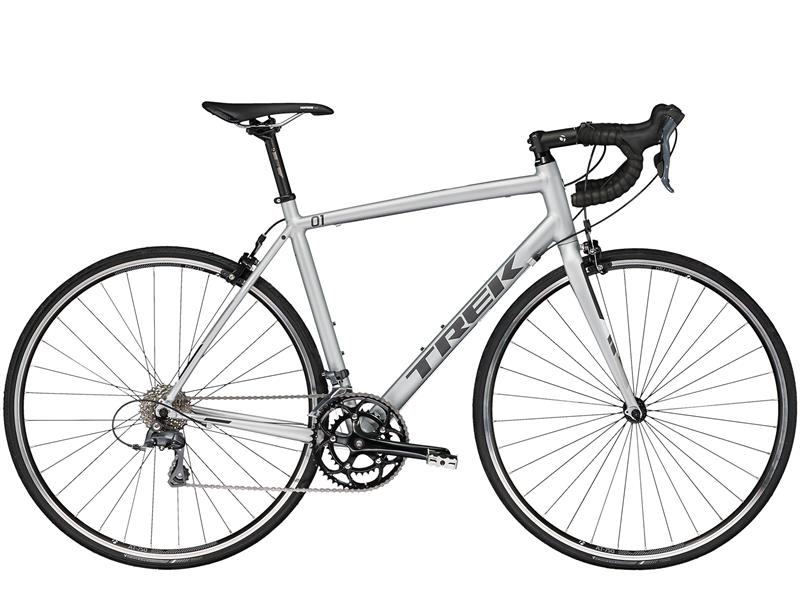
What we like about it: Fast, positive, confidence-inspiring, and fun. During the ride, I noticed less vibration transmitted through the forks into the handlebars, making it more enjoyable. The brakes worked well and required little effort to slow or stop the bike.
What we don’t like about it: Uncomfortable seat. My stock saddle has been replaced with one that is a bit more comfortable.
Trek uses the geometry that has been tested on the Pro Tour on every Trek road bike.
Buying a Trek 1.1 is choosing the most cost-effective ride quality! Performance = Ride Quality! It doesn’t matter what kind of kit is on the bike, the Trek 1.1 you pay for the same price is definitely more effortless and quicker to ride than any other brand of road bike in the same price range.
The Trek 1.1 aluminum road bike has the same aerodynamic shape and detailing as a high-end bike. The Trek 1.1 is sturdy, lightweight, and designed for zipping down the road.
With so many compliments, you can’t wait to learn about it, let’s get to know Trek 1.1 with our testers.
Main Features
Frame(4.6/5).
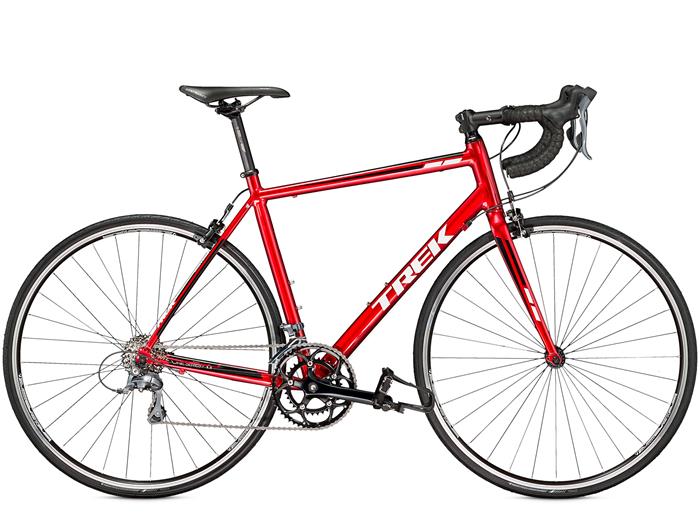
Aluminum alloy frames and components have been used throughout most of the history of the bicycle industry, but this does not mean that there is no possibility of continuous improvement and improvement.
For the Alpha Aluminum, Trek took the most complex metallurgy and pushed it to the limit—creating a strong, lightweight frame that delivers a riding experience that rivals many carbon frames.
The Trek 1.1 builds the frame with an Alpha Aluminum 100 Series for a more compliant frame, allowing the Trek 1.1 to maintain gold-hot acceleration performance at an affordable price.
With an Alpha Aluminum frame, you don’t have to think twice about hitting gravel trails or doing multi-day trips.
The Trek 1.1 will be an excellent companion for your vacation, travel, training, and competition.
The Trek 1.1’s Alpha Aluminum 100 Series frame features front and rear fender mounts designed for riders to ride in the rain and mud.
Geometry(4.7/5)
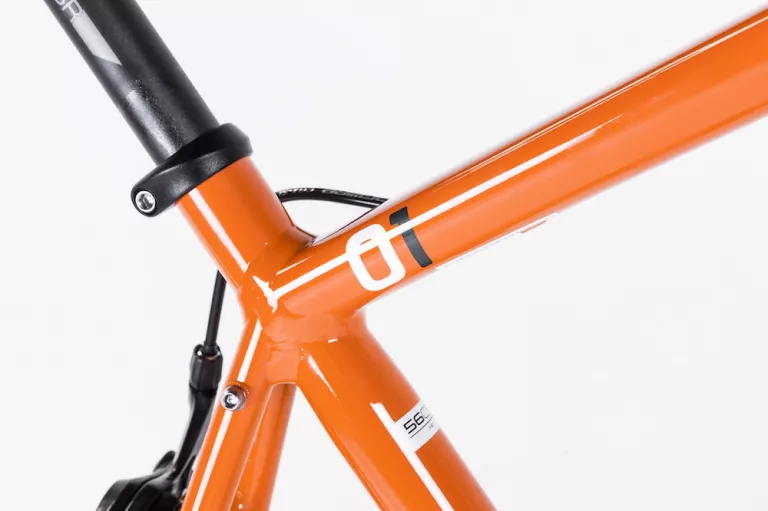
In Trek’s frame geometry, it is divided into “H1” and “H2”.
The H1 frame has a lower head tube and longer reach; the H2 frame has a higher head tube and a deeper depth.
Simply put, the H1 is suitable for aggressive riding positions, and the H2 is suitable for relatively comfortable, or durable riding positions.
Therefore, Trek 1.1 can also see its design logic with H2 geometry.
Components and Specifications
Drivetrain(4.5/5).
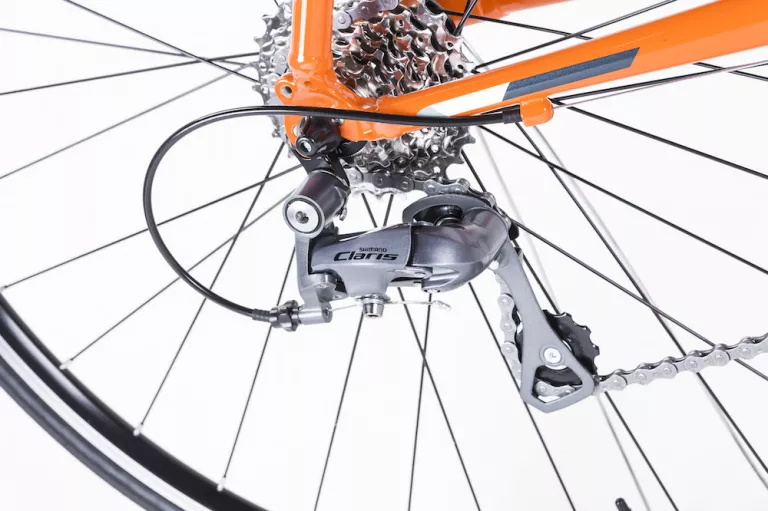
Trek 1.1 shifters use Shimano Claris, 8 speed, and both front and rear derailleurs use Shimano Claris.
Trek 1.1 Shimano Claris, 8-speed shifter Feel comfortable, ergonomically shaped, and with 2×8 speed road drivetrain compatibility, Shimano Claris dual levers provide accurate shifting and confident braking.
In our testers’ eyes, the durable and low-maintenance 8-speed drivetrain gives you the best gear range on a Trek 1.1 road bike.
Simple and intuitive dual control levers provide the Trek 1.1 with a comfortable ride.
Front and rear derailleurs
Our testers found the Shimano Claris rear derailleur on the Trek 1.1 to be a highlight.
Especially when shifting along with the flywheel into a more difficult-to-adjust gear during shifting, the shifting can also be precise and relatively sensitive.
When you and your buddies are conquering a steep hill or sprinting, it works perfectly under that load.
If you take these things into consideration, you’re in awe of the fact that the Trek 1.1 has a Shimano Claris rear derailleur.
One thing our testers also mentioned, however, is that we all know that the Shimano Claris is an 8-speed system, and the chain jumps between the gears a bit.
This puts pressure on the rear derailleur, and the details of smooth shifting are also something we need to pay attention to.
Dropping the chain from the large ring of the sprocket to the small ring is easy, but the reverse is not the same thing.
The Shimano Claris front derailleur pull-arm is much shorter than Shimano’s other pricier series. Our testers felt that it took a lot of effort to keep pushing the front derailleur to make a sustained shift.
It’s not a big problem, but in case of rain or cold winter weather, your fingers may not be able to control it very flexibly.
Trek 1.1 cranks are Vuelta Corsa, 50/34 (compact). Vuelta Corsa, 50/34 (compact) cranks are cold-forged and have a durable coating.
Chainrings with 110mm BCD compact steel. Gearing of 50T/34T, designed for indexed shifting. Shimano M371 cranks have good rigidity, durability, and lubrication after testing.
This product definitely met our testers’ expectations. Vuelta Corsa, 50/34 (compact) is also cheap.
The Trek 1.1 has a sprocket range of 11-28T, and the individual sprockets are precisely positioned relative to each other, ensuring the chain moves smoothly between the gears.
The Trek 1.1 uses a Sun Race CSR86, 8-speed cassette, and a net weight of 235 grams, which is very light.
In the eyes of our testers, the Sun Race brand cassette looked better than Shimano’s.
The Sun Race CSR86, 11-28, 8-speed shifts quickly and smoothly.
When we tested it violently, it was found that there was no excessive wear, which was also due to the good nickel-plated protective layer on the surface.
Pedals(4.4/5)
The Trek 1.1 pedals feature nylon composite treads, and the pedals themselves are fairly large.
The whole tread feels very comfortable. Nylon pedals are better than alloy pedals in terms of durability, more wear-resistant, and are less prone to deformation.
Fork (4.3/5)
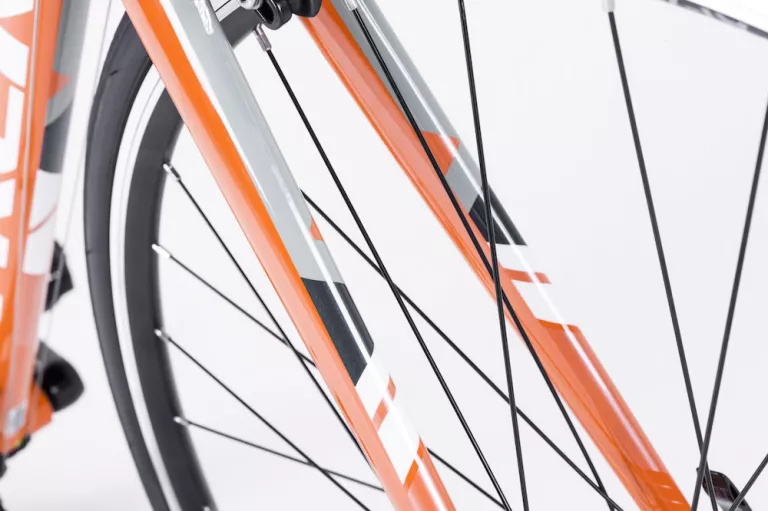
Carbon fiber not only has the inherent characteristics of carbon materials but also has the soft processing properties of textile fibers. Its specific gravity is less than 1/4 that of steel, but its strength is very high, and its corrosion resistance is excellent.
The Trek 1.1 front fork uses a Trek carbon fiber road fork, which reduces the weight of the entire vehicle and can indirectly increase the speed. Moreover, the carbon fiber front fork has good elasticity and can absorb more vibrations from the ground.
Bottom Bracket(4.5/5)
Generally, cartridge bottom brackets have two main components. The cartridge itself consists of the sealed bearings and spindle and is usually threaded into your frame’s right (drive side). The lockring is threaded into the left (or non-drive) side of the frame, and it supports the opposite end of the cartridge.
Bottom brackets should be installed and left alone. A sealed unit is what’s popular because it does not require maintenance.
Headset(4.6/5)
Trek 1.1 only a small section of the headset can be seen from the appearance, and the size of the frame pipe diameter will be larger to cover the entire set of internal parts.
In addition, the lower bearing of the hidden head bowl needs to be selected according to the angle of the front fork.
The Trek 1.1 uses a headset with 1-1/8″ integrated, semi-cartridge bearings.
This headset is made from a quality aluminum alloy material that is anti-rust, sturdy, and durable. Fine machining ensures a sleek surface, and the headset fits perfectly.
Dust and water can be kept away by the cap thus extending the life of the device. Using this bicycle headset, you can prevent the bearing from over-abrasion and allow it to rotate freely.
The Trek 1.2 and Trek X-Caliber 6 use the same headset as the Trek 1.1.
Wheels(4.3/5)

Trek 1.1 wheels feature Alloy hubs; Bontrager AT-750 double-walled alloy rims.
The Bontrager AT-750 rims used on the Trek 1.1 are dual-wall rims. Bontrager AT-750 double-walled alloy rims generally have the best strength-to-weight ratio.
You’ll find it on most intermediate to pro-level bikes.
They have a huge performance advantage over single-wall rims, which our testers recommend for any level of riding.
The Trek 1.1 front and rear hubs use Alloy. The hub can be said to be the core component of the wheelset.
When you decide to build a wheelset, basically everyone will start with the hub to choose from.
Alloy’s focus is on smooth rolling and minimal loss of power. Trek 1.1 front and rear hubs are made of aluminum alloy.
The surface of aluminum is anodized, by immersing aluminum in a special solution, and then through a series of chemical reactions such as the electrolysis of water, a dense and solid oxide layer is formed on the aluminum.
The Trek 1.1 uses Bontrager T1, 700x25c tires with a super-strong nylon shell, 700mm outer diameter, and 25mm width.
The tire has an engineered tread design for confidence in wet or dry conditions.
The Bontrager T1 tread uses a durable compound for longer life. Our tester had a Trek 1.2 in hand, and the Bontrager T1 has always been our tester’s stock tire.
In addition to a flat tire, he ran 4,000 miles when he hit a chunk of steel, puncturing the tire and tube. Our testers patched the tubes and re-used the tires and are still using Bontrager T1 tires.
This shows how well the Bontrager T1 is used by our testers!
Trek 1.1 Spece
1. On this bike, what is the largest tyre size I can fit (in mm, e.g. 700x25C)?
Bontrager’s 700 x 25c tire is the largest tire we recommend for the 1.1.
2. Is there a way to find the serial number on my bike?
Located beneath your cranks, your serial number begins with the letters “WTU” followed by a string of numbers and letters.
3. What is the number of gears on Trek 1. 1?
4. Can you tell me how much this bike weighs?
There is no need to worry about shipping since the 56 cm Domane AL 2 weighs 9.92 kg / 21.87 lbs.
Comparison table
Schwinn vantage f2 700c vs trek 1.1.

The Schwinn Vantage F2 700c is about $170 more expensive than the Trek 1.1.
The positioning of the two road cars is also different. The Schwinn Vantage F2 700c is more suitable for healthy riding, and many people will choose to ride the Schwinn Vantage F2 700c in their spare time to relieve stress. ( Who Are The People Who Still Insist On Cycling In The Summer? -Interesting Cycling Facts ) And Trek 1.1 is better for speed racing.
The Schwinn Vantage F2 700c fork is aluminum, and the Trek 1.1 is carbon fiber( Trek 1.2 fork also uses carbon fiber.).
As a racing car, Trek 1.1 chose a carbon fiber front fork, which is light in weight and strong in shock absorption.
Compared with carbon fiber, the aluminum alloy front fork has no advantage in weight, and the shock resistance is slightly weaker.
But for the Schwinn Vantage F2 700, which is usually used for healthy riding, it doesn’t matter much.
The Schwinn Vantage F2 700c uses a mechanical disc brake, which relies on the pull of the brake cable to rub the brake pads in the caliper and clamp the disc to produce a braking effect.
The disc brakes give me a solid feel, but I prefer, or rather get used to, the feedback I get from the pads hitting the rims on the Trek 1.1 rim brakes. And this kind of feedback is not found in the disc brake type.
Moreover, the rim brakes can also bring a light feel and good feedback when combined with excellent cable tubes and routing.
Acera, Tourney shifting kits are configured on the Schwinn Vantage F2 700c, which also reflects the positioning of the road bike – leisure, entertainment.
The Claris is one of the lower-end kits in Shimano’s lineup. It’s designed for light exercise, long rides, town cruising in casual clothing, shopping, and daily commutes.
But why use the Trek 1.1, a road bike positioned for speed competition? Our testers never understood the designer’s design logic.
Learn more: Schwinn 700c Prelude Road Bike Review
Fuji Jari 2.5 vs Trek 1.1
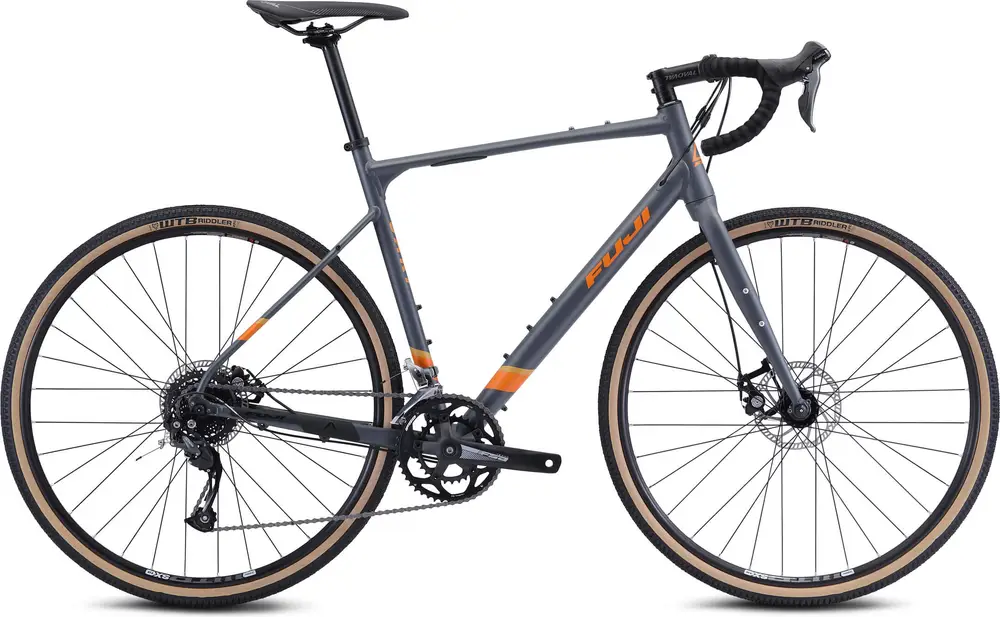
Unlike Trek 1.1, the Fuji Jari 2.5 is a bike that does a great job on gravel road bikes today.
The Fuji Jari 2.5 is equipped with a 1400-gram lightweight A6 aluminum alloy frame, but the surface of the Jari 2.5 only has a transparent coating material.
The Trek 1.1 has a carbon fiber fork, while the Fuji Jari 2.5 has a chrome-molybdenum fork.
The chrome-molybdenum steel frame is suitable for long-distance riding, especially long-distance road riding, which makes the Fuji Jari 2.5 very good for fine vibration damping on the road surface.
The chrome-molybdenum steel material itself is relatively elastic. When making the frame, because the material itself is better and more durable, the tube wall is usually thinner, resulting in greater elasticity.
The Fuji Jari 2.5 is not easy to get tired of riding, but the frame is soft, not suitable for competition, and not suitable for power.
Fuji’s exclusive parts manufacturer, Oval, specially designed the handlebar for the Jari Jari 2.5. It is made of 6061 aluminum alloy and has a drop distance of 125 mm between the upper and lower handlebars.
The handlebar position is quicker under normal riding posture, and it is also quite suitable for relatively small arms. People who are short or have a phobia of gripping.
There is a 25° flare angle in the lower handle position, which reduces wrist flexion in the lower handle position and reduces fatigue accumulation.
The Jari Jari 2.5 head tube angle ranges from 70.5° on the smallest frame size to 72° on the larger frame. The slack head tube angle is a setting biased towards gravel bikes. The chainstay length is 435mm for all frame sizes, which is 1cm longer than a typical cyclocross bike.
Vitus Razor vs Trek 1.1
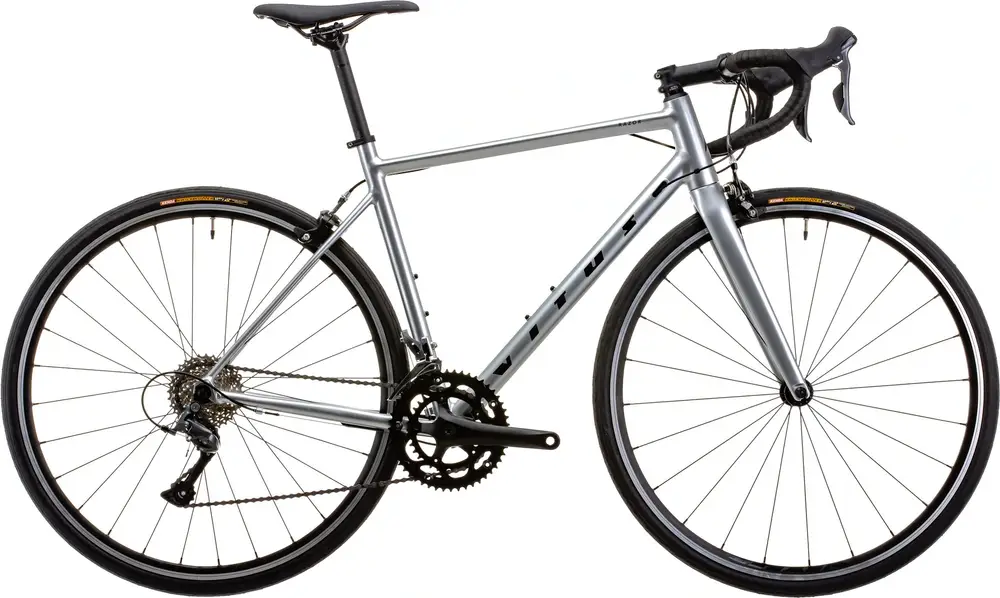
The Vitus Razor is 1.0 kg lighter than the Trek 1.1. Other than that, the two cars are roughly like twin sisters.
Featuring an all-new modern 6061-T6 Double Butted Aluminium frame and full UD T-700 carbon fork, the Razor features a tapered frame to give you lightweight, speed, handling, and The perfect balance of comfort.
The Vitus Razor is equipped with Shimano’s efficient and reliable Claris R2000 8-S drivetrain, while the Trek 1.1 is paired with a Shimano Claris drivetrain.
The Vitus Razor has Tektro R317 rim brakes and Vitus 700c road wheels with elegant-looking Vee Road Runner 700c x 28 tires for great performance and grip in all conditions.
The Trek 1.1 features Alloy dual-pivot braking, a dual-pivot design that enables a lightweight, compact, and durable braking system. Dual-pivot caliper brakes have come a long way in reducing tolerances and deflections as well as durability.
Trek 1.1 achieves firm and immediate braking response while ensuring longer life. In addition, the durability of the brake pads has been increased by 100%, helping Trek 1.1 to enjoy highly responsive braking for longer periods of time.
Cervélo Caledonia 105 vs Trek 1.1
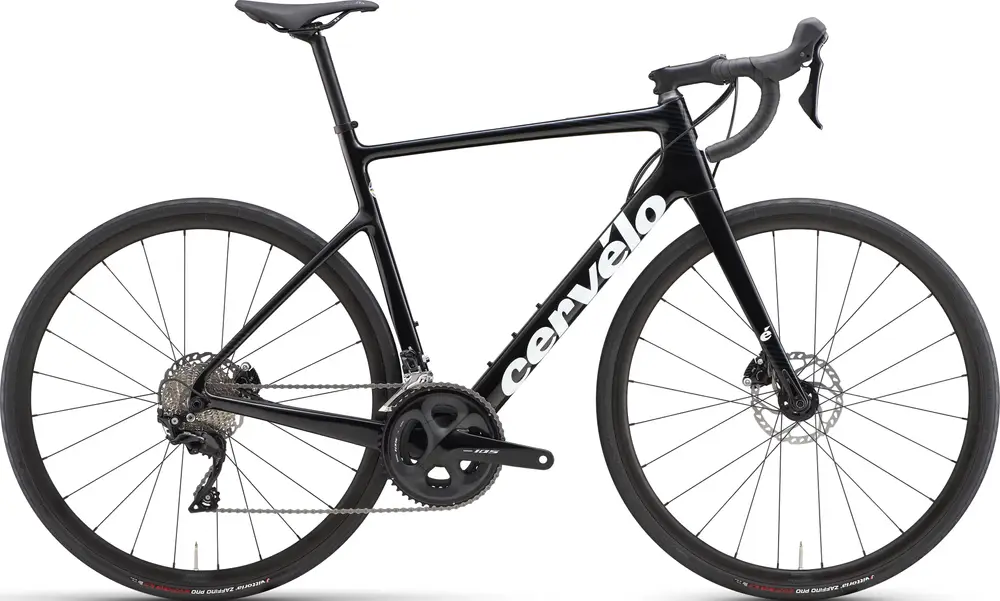
Cervélo Caledonia 105 is more than 4 times the price of Trek 1.1.
Cervélo Caledonia 105 starts from the tube shape, all the way to the design of aerodynamics, high stiffness, lightweight, etc., to meet the performance requirements of a competition-level road car.
In the eyes of our testers, the Cervélo Caledonia 105 is the nobility of road bikes.
Cervélo Caledonia 105’s internal cable routing solution, split spacers, U-shaped fork steerer, and other designs have been further optimized.
Not only is the system simple and beautiful, but it is also much lighter (save 200 grams) and meets the rider’s requirements for the fit range.
This simplicity is also far more than just aesthetics—it even affects how fast it rides, as nothing interferes with the airflow in the front end.
The Cervélo Caledonia 105 seat tube is cut to better wrap the rear wheel and effectively reduce wind resistance. Di2 fully internal routing handlebar design; shared with the s-series of the broken tube design, these are for the Cervélo Caledonia 105 ride aero performance considerations. Wow, really versatile.
Cervélo Caledonia 105 chainstays are designed to move down to effectively improve compliance. With a larger stack height and a shorter reach, the geometry is more relaxed.
In addition, the Cervélo Caledonia 105 uses Vittoria Zaffiro Pro V Folding G2.0 30c tires with a maximum tire size of 34 mm. These factors all add up to take into account its comfort.
Excited, our testers completely forgot about Trek 1.1’s merits and turned all their attention to the Cervélo Caledonia 105.
Comprehensive evaluation(4.4/5)
The Trek 1.1 is affordable and of good quality overall frame and components, making it a very good starter bike. Trek 1.1 shifts smoothly and easily when you get the hang of shifting. And the range of gears allows you to handle all types of hills well, even on short, steep trails.
It’s worth mentioning that you need to notice that the Trek 1.1’s fork transmits very little vibration to the handlebars, making it a lot more enjoyable to ride.
Learn more: Top 10 Best Road Bikes Under $1000 – Great Value For Money
Related Posts
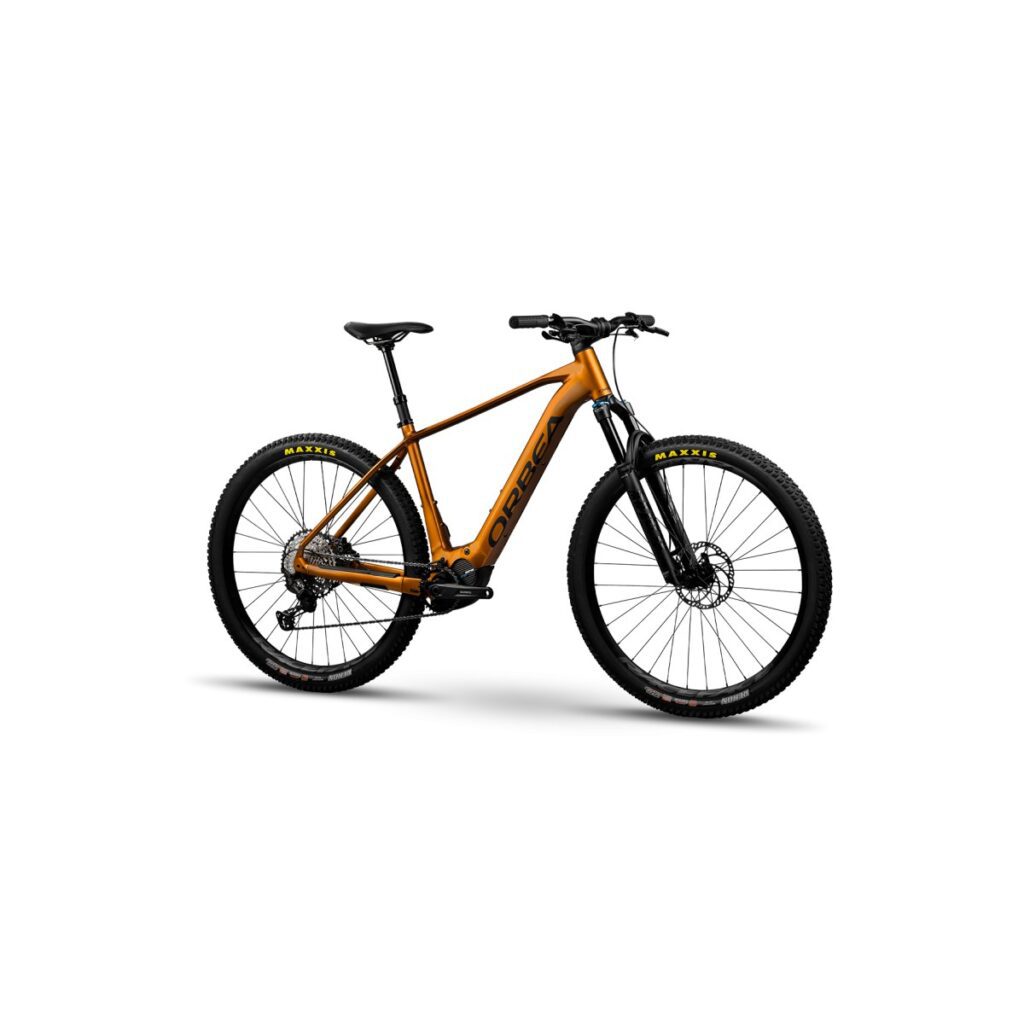
[Orbea URRUN 10 20mph Review] – Best Used By People Who Enjoy Riding To Get AFeel For The Mountains!
[schwinn admiral hybrid bicycle review] -is schwinn admiral hybrid bicycle worth buying?.

[Specialized Turbo Como 5.0 Review] – Good Choice?
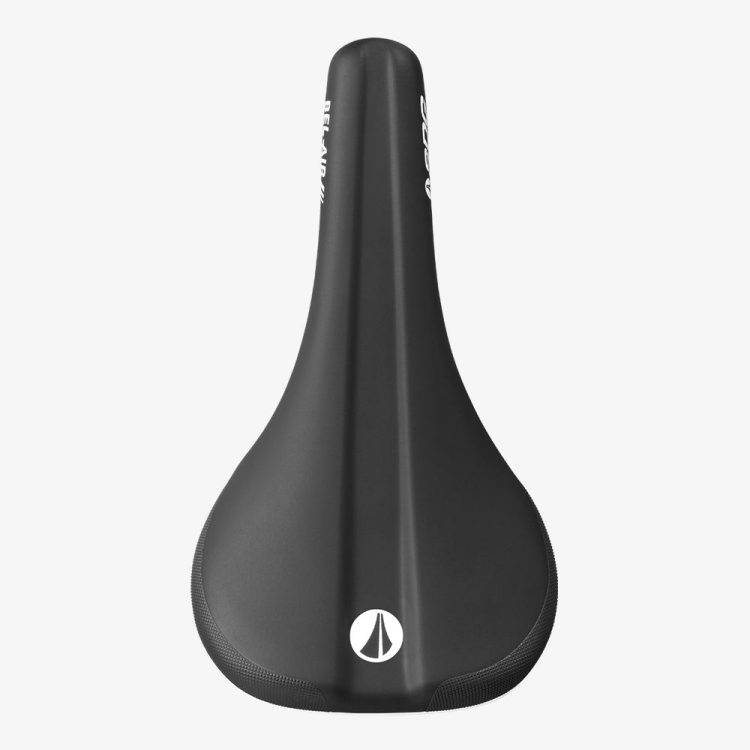
15 of The Best Mountain Bike Saddles You Can Buy
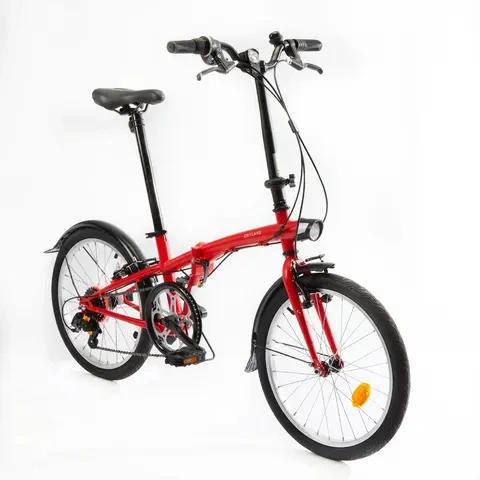
20 INCH FOLDING BIKE BTWIN 120 Review-Fold up and put in “pocket”

2023 Top 10 Best Fun Kids Bike Bells – Will This Bring Joy To Your Child’s Ride?
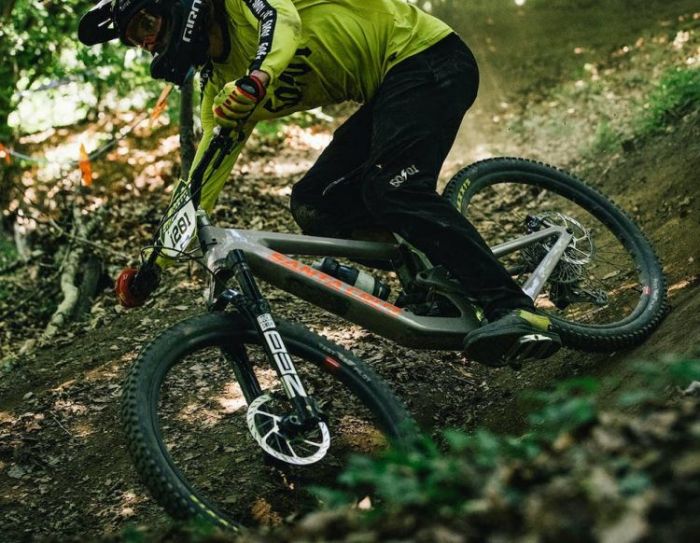
27.5 vs 29er Mountain Bikes – The Battle Of The Century

Best 20 inch Bikes For 6-13 Years Old Kids Bikes (With Gears)
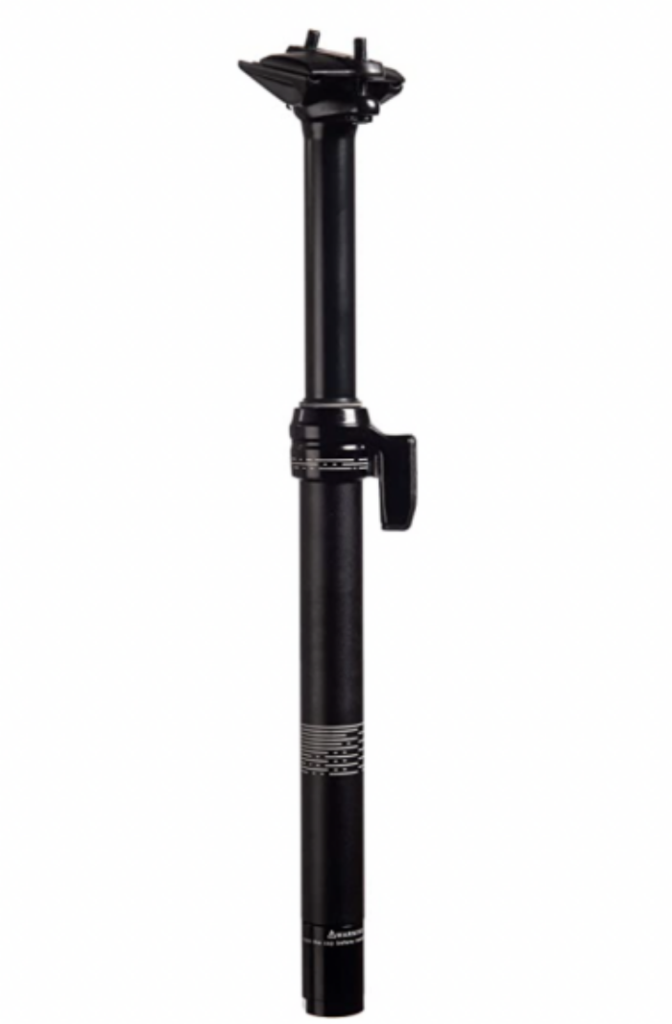
Best 27.2 Dropper Post

Best 30.9 Dropper Post In
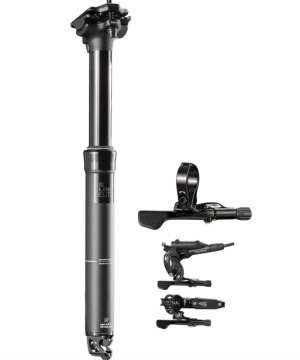
Best 31.6 Dropper Post

Best Mountain Bike Stems-Better Travel Through The Mountains And Forests
Leave a comment cancel reply.
You must be logged in to post a comment.


- ALL (67 Forums)
- WHEELS & TIRES
- SPECIALIZED
- CYCLOCROSS BIKES
- TIRES & WHEELS
Trek 1.1 Road Bike

- Frame: Alpha White Aluminum
- Fork: Aluminum
- Wheels: Alloy hubs; Bontrager Approved alloy rims
- Tires: Bontrager Sport, 700x23c
- Shifters: Shimano 2300 STI, 8 speed
- USER REVIEWS
The frame is great value for money, and the components won't leave you feeling let down. The handling is good for beginners, not too snappy to make for a twitchy ride but still responsive enough to have lots of fun with- goes where you want it to. Frame reasonably comfortable for an alloy frame, and stiff enough for all but the most dedicated racers. Mudguard and rack mounts adds versatility.
Cheap finishing kit that could be upgraded to make the most of the frame- tyres are very susceptible to punctures and should be thrown away as soon as possible.
I've had my 2011 model for nearly 4 years, with about 15000miles put into it so far and I can't say I have any complaints about the quality of the frame. It is currently my only road bike so I do all of my general club riding, training and racing on it, and it's taken it all in its stride. I have replaced all of the moving parts on the machine as they have worn out (to be expected on a budget machine) but I still find the frame and forks to be comfortable enough, and although you can see some flex in the bottom bracket when putting in big efforts this shouldn't be a problem for the target market. The wheels are very strong, and are pretty much the same as the reputable shimano RS501 wheels used by many for training and winter use, and never needed truing for the 10000 miles they lasted. The jagwire cabling is also commended- the inners lasted for 3 years before replacement with not a great deal of stretch, and the outers are still in reasonable condition. However, the stock tyres punctured every 12 miles like clockwork, and were replaced after 3 rides to a pair that had no such issues. There is plenty of clearance for full length mudguards, which are great for general mile munching in temperate climates where rain is common- and the extra bosses for a rear rack add to the versatility of the bike, so you can use it for light touring if you wanted to. This is a great bike if you are thinking of getting into road bikes, as the frame is good enough to deserve upgrading with better components if your interest grows and you want better performing kit for racing or just for your own enjoyment. It would also serve as a very capable and racy winter training bike if you chose to upgrade to a new bike for the drier months or special events. I will certainly be keeping mine well into the future after purchasing a dedicated racing machine.
This is an EXCELLENT entry level bike! Emphasis on ENTRY LEVEL. I have put over 3000 miles on it, and am still able to honestly say money WELL spent, even though if I knew that I was going to put SO many miles on, I would have gone with a higher level bike! I was new to road biking. I had a Trek 820 MTB that I used on the local trails on rare occasion, but out of the blue, I have had several friends who randomly asked if I wanted to do some long rides. I wasn't sure how well I would take to road biking, but as a kid growing up in Iowa, RAGBRAI would come through my hometown a couple of times, and I always thought it would be cool to do something like that. So, I bought the 2010 Trek 1.1 as a graduation present to myself for finishing grad school, and what a gift to myself! After 3000 miles, I am ready for an upgrade, but the bike will stay in the family and go to my son when I finally save the cash to buy up on a better bike! In the 5 (or more) years that I had the Trek 820, I didn't put a total of 100 miles on it, and now I ride over 100 miles a WEEK during the riding season!
The factory seat was TERRIBLE. I got a $8.00 seat from Walmart that was 100x's better than what came with the bike. I now have a Serfas Gel Seat, and it is great. The Shimano 2300 components are a bit finicky on shifting, but it isn't a complete washout on them. This is still much more bike than I have ever owned, and I am enjoying it A LOT! 3000 miles, a lot!!! I am a big guy, when I bought the bike I was over 270lbs. I am now down to about 250. I did have to upgrade the back wheel to a 36 spoke count because I kept popping spokes on the 32 spoke that came with the bike. I popped 3-4 spokes in about the first 1000 miles, and since upgrading to the 36 spoke Velocity 105 compatible wheel, I haven't popped a SINGLE spoke. factory tire didn't last long... Have tried a few different tires and now have Continental Tires and love them, MUCH more durable!
If at purchase I knew that I was going to be putting on 3000 miles in the first year, I would have bought up a couple levels. However, I didn't know. That being said, this is a great bike! In high school, I had a Huffy 626. In college, I bought a cheap WalMart MTB that was trash. About 5 years ago, I bought the Trek 820 MTB which I still own and use when the kids ride along and I need to slow down to help them keep up! So, this is far and away, the fastest and lightest and nicest bike I have ever dreamed of owning. I never thought I would spend even $500 on a closeout bike without gagging on the thought of that much cash going into a BICYCLE!!! I never knew that there really was that much difference in bicycles. This experience has opened my eyes to a whole new world, and makes the city I live in, much more scenic and special place to live! This bike, more specifically, has helped me lose some weight and ride to support research for Breast Cancer, Multiple Sclerosis, Diabetes and other organizations! I would have NEVER thought that just over a year since the purchase, I would have over 3000 miles on a BIKE, but I do.
Similar Products Used:
I have ridden Giant Defy 3, Bianchi via Nirone, Specialized TriCross and a few others in the low to low/mid level. I really liked the shock absorption in the TriCross, but I was on a budget and opted for the 1.1. Giant Defy 3 was great, and if price was the same, would have gone with Giant Defy 3, but I was able to get a great deal on the 2010 1.1, in April 2011.
Vaule, quick handling/accelration, fairly versatile.
Entry level components
I got this 2010 bike used in July 2011, as an affordable bike for general recreation riding and running errands, with occasional overnight “light touring” trips. 800+ miles later it has served all those purposes well. The bike looked brand new, with no sign of previous use. It came with 2 left toe-clips, and a severally misadjusted from derailer; don’t know if this was Trek’s fault, the LBS where I got it, or the original owner. This is the “Compact“ version with 50/36 chain ring and a 8 speed 12-25 cassette. This is enough gearing for the type of riding I do. This is Trek’s entry level road bike, and you can see what they cut out to keep the price down. The Shimano 2300 derailers/shifters baulk sometimes but the drivetrain runs smooth once in gear. The brakes stop well enough but the need constant adjustment and oiling to keep one pad from dragging after release. And the original saddle was an ass-hatchet (I replaced it.) The bike has braze-ons for fenders but I use the extra frame room to mount bigger tires. The bike came with 700C x 23 mm, but I run a 28mm in the back most of the time, and 32mm back/28mm front for long trips. The 32 mms just barely clear the seat post, and mounting anything bigger than 23mm requires a little force to get them past the brake calipers. I have also run this bike on dirt roads/trails with 20 year old rusted steel wheels and 27” x 1¼” (630mm x 32mm) treaded tires (to avoid damage to the 32 spoke wheels the bike came with.) The old rear wheel has 6 sprockets, and with a little adjustment I can get the 8 speed shifters to work with it. The bike accelerates and changes direction quickly, especially with the skinny tires. It rides comfortably with the thicker tires. It tracks straight when riding with no-hands. And I’ve carried 20 lbs on the rear rack with ease. You can get a nicer bike by spending more money. But so far this bike has been fun, reliable and a good value.
1982 Ross Grand Tour
Get the latest road bike reviews, news, race results, and much more by signing up for the Roadbikereview Newsletter
Hot Deals See All Hot Deals >>
Get the latest roadbike reviews, news, race results, and much more by signing up for the Roadbikereview Newsletter
- EDITORIAL REVIEWS
- CLASSIFIEDS
ABOUT ROADBIKEREVIEW
- TERMS OF USE
- PRIVACY POLICY
- ADVERTISING
VISIT US AT
© Copyright 2024 VerticalScope Inc. All rights reserved.
- Specialized
- Bridge Bikeworks
- Brooklyn Bicycle Co.
- Bunch Bikes
- CYCLE OF GOOD
- DALLINGRIDGE
- Diamondback
- Eddy Merckx
- Electric Bike Company
- EVO Bicycles
- Fahrradmanufaktur
- Flyer by Radio Flyer
- iGO Electric
- Intense 951
- JupiterBike
- Lectric eBikes
- LeMond Bicycles
- Lightweight
- View all brands
- Pivot Cycles
- Qualisports
- Quintana Roo
- Rad Power Bikes
- Raleigh Electric
- Riese & Müller
- Rocky Mountain
- Schindelhauer
- State Bicycle Co.
- Surface 604
- Urban Arrow
- Van Nicholas
- VELO DE VILLE
- Vintage Electric
- Yeti Cycles
- YT Industries

Trek 1.1 C H2
- AUS $ NZD $ USD $ CAD $ GBP £ EUR €
At a glance
Trek’s 1.1 is a great choice for road riding fun. It boasts Trek’s light, nimble-handling Alpha aluminum frame that has a slightly higher front end and elevated handlebars for comfort. To make the most of that increased comfort, this sweet road machine is equipped with easy-rolling Bontrager wheels and tires, powerful dual-pivot brakes for confidence and control, and a 16-speed drivetrain with a wide-range crankset for flying up the climbs. You’ll also appreciate the Bontrager saddle, bars, stem, and bar tape— touchpoints that balance performance and comfort.
Where To Buy

Specifications
- Frame 100 Series Alpha Aluminum, rack and fender mounts
- Hubs Bontrager alloy
- Chain SunRace CNM84
- Crank Vuelta Corsa
- Bottom Bracket Sealed cartridge, English thread
- Front Derailleur Shimano Claris
- Rear Derailleur Shimano Claris
- Shifters Shimano Claris
- Brakeset Alloy dual-pivot
- Handlebar Bontrager Race VR-C, 31.8mm
- Saddle Bontrager Montrose Comp
- Seatpost Bontrager SSR, 2-bolt head, 27.2mm, 12mm offset
- Stem Bontrager Elite, 7 degree, w/computer & light mounts
- Grips Bontrager Microfiber tape
- Headset 1-1/8-inch integrated, semi-cartridge bearings
Q: How much is a 2017 Trek 1.1 C H2?
A 2017 Trek 1.1 C H2 is typically priced around $770 USD when new. Be sure to shop around for the best price, and also look to the used market for a great deal.
Q: What size 2017 Trek 1.1 C H2 should I get?
No comments on this bike yet. Why not be the first?
Leave a Reply Cancel reply
Your email address will not be published. Required fields are marked *
Want more road bikes in your mailbox?
The latest on road bikes delivered straight to your mailbox.

More General Bikes View All

Fuji Sportif 2.1
- The Sportif is designed for versatility and performance. Taking geometry cues from our top-level endurance bike, the Gran Fondo, the Sportif’s longer wheelbase and taller headtube position the rider…

Bianchi Specialissima Super Record
Bianchi’s Specialissima is a game-changer for the ultralight bike category. With NASA-developed Countervail technology, the Specialissima delivers a 780-gram frame that boasts an unparalleled ride quality, climbs like a rocket,…

Kona Roadhouse
The Roadhouse is Kona’s flagship Reynolds 853 road bike, combining the lively ride characteristics and aesthetics of classic steel bikes with the all the details you’d expect from a modern…
Deals View All
View all deals, recent posts view all.

What is Road Bike Database?
Whether you're a seasoned cyclist or just starting out, choosing the right road bike can…
Send Feedback
Have a suggestion? Looking for a bike that's not on Road Bike Database? Or perhaps you've spotted an error?
We'd love to hear from you. Let us know with the form below.
This website uses cookies to ensure you get the best experience possible. Learn more.
About Road Bike Database
Explore, search and compare thousands of the world’s best road bikes here on Road Bike Database.
Compare prices, components, reviews, images and more on current and past road bikes. You can even share reviews, comments and questions on road bikes. View and compare a huge selection of bikes from brands such as Cervélo , BMC , Trek , Specialized and more .
We strive to provide accurate and up-to-date information for road bikes on Road Bike Database. If you’ve spotted any issues, please let us know . We also include helpful tools, such as our frame size calculator, to assist you in choosing the right road bike. Bear in mind that these tools serve as a guide and simply provide a general indication. Refer to information provided by your bike manufacturer for the most applicable information for your bike.
Bikes By Brand
Bikes by year, bikes by riding style.
- Electric Road
- folding-bike
- general-road
- general-urban
- long-tail-cargo
Bikes By Wheel Size
Popular bikes.
- 2022 Bergamont E-Horizon Elite Belt Amsterdam
- 2023 Kellys ESTIMA 10 SH 504Wh
- 2023 Tern Link D7i
- 2023 Rose MULTISTREET 3 MidStep
- 2022 ARC8 Escapee DB DURA ACE DI2
- 2023 Riese & Müller Supercharger GT vario HS
- 2022 Garneau Urbania 3
Latest Bikes
- 2024 Riese & Müller Delite4 GT touring
- 2024 Riese & Müller Delite4 GT rohloff
- 2024 Riese & Müller Delite4 GT rohloff HS
- 2024 Riese & Müller Delite4 GT vario HS
- 2024 Riese & Müller Delite4 GT vario
- 2024 Riese & Müller Delite4 GT touring HS
- 2024 Riese & Müller Roadster4 Mixte vario HS
- off.road.cc
- Dealclincher
- Fantasy Cycling
Support road.cc
Like this site? Help us to make it better.
- Sportive and endurance bikes
- Gravel and adventure bikes
- Urban and hybrid bikes
- Touring bikes
- Cyclocross bikes
- Electric bikes
- Folding bikes
- Fixed & singlespeed bikes
- Children's bikes
- Time trial bikes
- Accessories - misc
- Computer mounts
- Bike bags & cases
- Bottle cages
- Child seats
- Lights - front
- Lights - rear
- Lights - sets
- Pumps & CO2 inflators
- Puncture kits
- Reflectives
- Smart watches
- Stands and racks
- Arm & leg warmers
- Base layers
- Gloves - full finger
- Gloves - mitts
- Jerseys - casual
- Jerseys - long sleeve
- Jerseys - short sleeve
- Shorts & 3/4s
- Tights & longs
- Bar tape & grips
- Bottom brackets
- Brake & gear cables
- Brake & STI levers
- Brake pads & spares
- Cassettes & freewheels
- Chainsets & chainrings
- Derailleurs - front
- Derailleurs - rear
- Gear levers & shifters
- Handlebars & extensions
- Inner tubes
- Quick releases & skewers
- Energy & recovery bars
- Energy & recovery drinks
- Energy & recovery gels
- Heart rate monitors
- Hydration products
- Hydration systems
- Indoor trainers
- Power measurement
- Skincare & embrocation
- Training - misc
- Cleaning products
- Lubrication
- Tools - multitools
- Tools - Portable
- Tools - workshop
- Books, Maps & DVDs
- Camping and outdoor equipment
- Gifts & misc

The 1.2 is the middle of Trek's three 1 Series aluminium road bikes, sitting between the Shimano Claris-equipped 1.1 (£575) and the 1.5 (£750), which comes with Shimano Tiagra components.
Is it the right bike for you? We've picked out four reasons why it might be, along with a reason that might make you think twice.
1 It provides solid performance with few surprises
The 1.2 puts in a solid performance out on the road, offering a stable, predictable ride, the only real disappointment being the lack of braking power (see below).

Hitting the scales at 9.48kg (20.9lb), the 1.2 isn't as lively as many lighter bikes, but for £650 this is certainly a decent enough weight. Compared to bikes of a similar price, it accelerates well. You'll find a little more flex in the frame and fork than in higher level models in Trek's range, but this is a bike that's well capable of holding its own when you crank up the power.
You could't say that the 1.2 is the fastest climber but it's far from sluggish when things get lumpy. It's helped in its hill-climbing endeavours by a compact chainset (with 50-tooth and 34-tooth chainrings rather than 52 or 53 and 39). Most bikes of this price come with something similar these days. Matched up to an 11-28-tooth cassette, it'll allow you to get up the vast majority of gradients without your knees popping or your lungs bursting, while still providing enough big gears to keep you bowling along quickly on the flat and downhill.
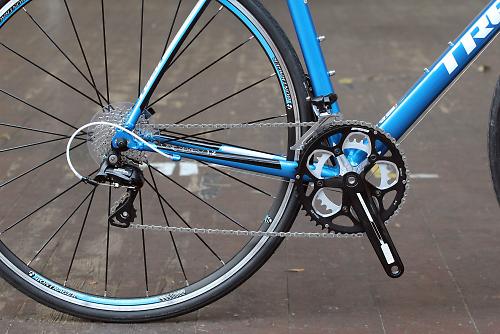
Aluminium frames have a reputation for feeling harsh but that's a gross generalisation. Some are jarring – as some carbon frames are – but plenty aren't. This bike is certainly comfortable enough for racking up the big miles.
For a start, it comes in Trek's H2 fit. That requires a brief explanation. Compared to Trek's H1 fit, H2 has a taller head tube: 3cm taller in the case of our 58cm test model. Why? It puts you into a more upright riding position with less strain on your lower back and neck. You could achieve a similar position by adding a bunch of headset spacers on an H1 bike, but if you want your bars at that height, you're better off going for an H2 fit because the front end will be stiffer and the handling will be better.
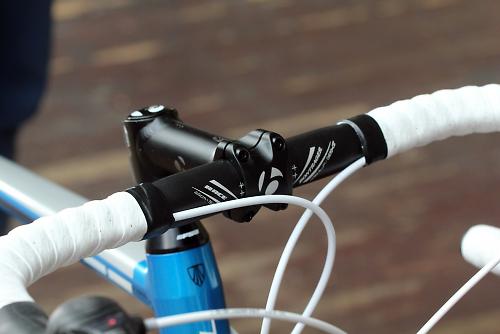
The Bontrager Race VR-C alloy handlebar has a shallower drop than usual too: 124mm rather than the 145mm you get on Bontrager's Race Lite Classic, for example. That means it's that much easier to get down on the drops. A lot of people have a bar with a deep drop and rarely take their hands off the hoods.
The other reason for the comfort is that the 1.2 is inherently pretty smooth. Sure, there are plenty of bikes out there that will filter our more road vibration but this one does a decent enough job on that front. Swapping the 23mm tyres for 25s would add more comfort but this bike isn't crying out for them by any means.
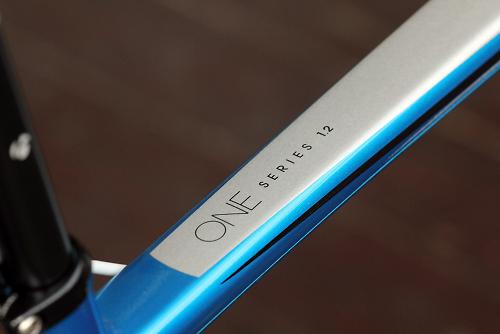
The Bontrager Gel Cork bar tape provides good cushioning for your hands and the Bontrager Affinity 1 saddle has plenty of padding too. Truth be told, I found it a little too soft, verging on squidgy, but everyone has their own taste when it comes to saddles.
2 You get a neat, well-proven frame and fork
All three bikes in the 1 Series share the same 100 Series Alpha Aluminium frame. It's fairly busy looking with a squared off upper edge to the down tube that makes it resemble that of Trek's more costly Madone.
The top tube slopes towards the seat tube junction and tapers down as it does so, and slim seatstays provide compliance at the back.
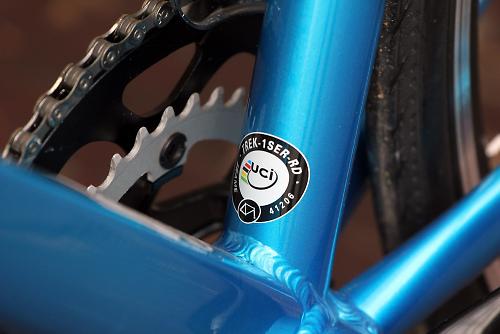
You get mounts for a mudguard and a rack back there too. They'll be useful if you want to ride the bike year round and perhaps carry stuff to and from work on a daily commute.
You don't get the oversized bottom bracket or tapered head tube that are regular features designed to add stiffness to higher-end performance bikes, but this is a £650 bike and the frame is good for the money. The welds are pretty tidy throughout and the same can be said of the paint job.
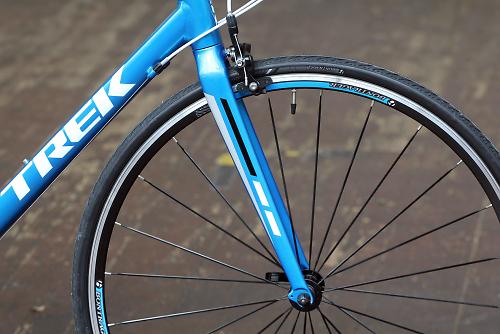
The fork is Trek's own with carbon blades and an alloy steerer. Like the frame, it comes with eyelets for fitting mudguards that will save a lot of faffing.
It's worth noting that the Trek 1.2 is available in eight sizes from 47cm up to 62cm. That range will cover nearly everyone.
3 Shimano's Sora shifters and mechs are excellent for the money
Nine-speed Sora is Shimano's fifth tier road groupset (if you don't count the electronic variants) and it offers fantastic value for money.
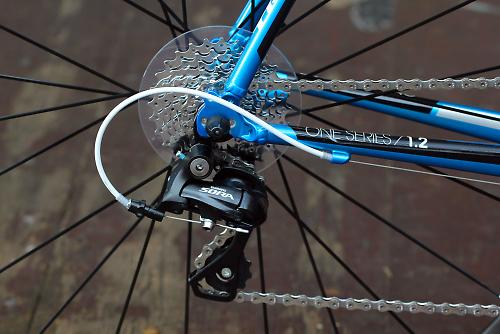
Back in the olden days (before last year), you changed gear on Sora by pushing the brake lever to the side or by using a small thumb lever on the side of the shifter body, depending on the direction you wanted to shift.
Now, though, Sora levers are Dual Control, so instead of that thumb lever, there's a lever tucked behind the brake lever. It's the same design that Shimano use right up to top-level Dura-Ace and it's a big improvement, making it far easier to change gear from the drops.
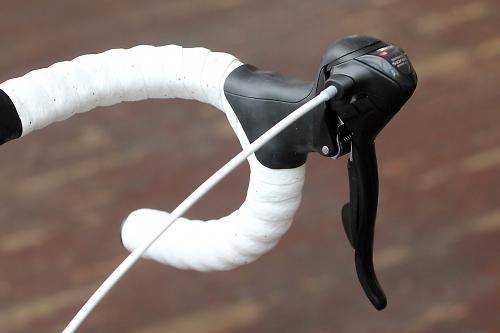
Resting your hands on the hoods is comfortable and there's a little gear indicator on the top of each of the levers that you might find useful. I can't say I ever checked them – I just couldn't get into the habit – but they're there if you want to.
Whereas the gear cables run underneath the bar tape on Shimano's higher level groupsets, they head out from the side of the levers with Sora and loop around to the frame in the fresh air. That's certainly not a problem from a functional point of view, although visually it's a less tidy way of doing things. That's being picky, though. Sora shifting has taken a massive leap forward with this latest design. It works very much like the highest level offerings from Shimano, just adding a little weight. Even there, the difference isn't massive.
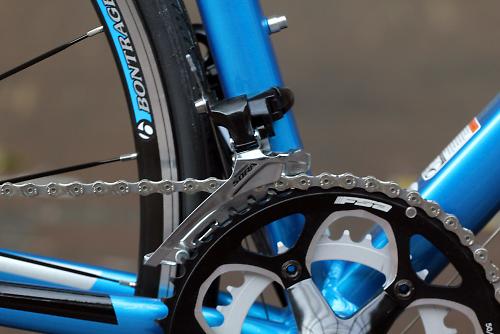
Trek don't give you a complete Sora groupset here, just the shifters and mechs. The chainset is FSA Vero, a square taper design that does its job just fine, and the brakes, as mentioned, are unbranded.
Most other big brand bikes at this price, such as the Giant Defy 3 (£649) and the Felt F95 (£649), have Shimano Sora components too. It's worth comparing the spec sheets to see exactly how they match up, but don't buy a bike solely on that basis.
4 Bontrager's wheels and other components are good, reliable kit
The wheels are made up from Bontrager's own alloy hubs, containing cup and cone (rather than cartridge) bearings, and Tubeless Ready http://www.bontrager.com/technology/why_tubeless_ready rims. That means you can run the wheels without inner tubes at some point in the future, although you'll need to upgrade to Tubeless Ready tyres first.
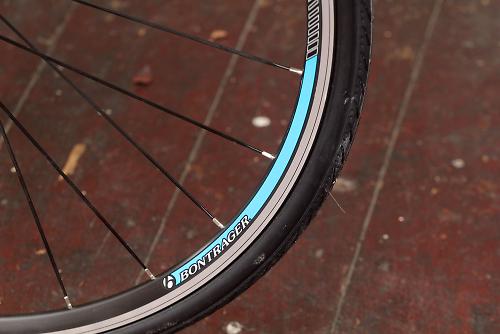
The tyres that come fitted as standard are Bontrager's T1s (700 x 23). They're some pretty hefty rubber, made for durability rather than all-out speed, but they're reasonably resistant to punctures and they hold the road well even in damp conditions.
I had no problems at all with the wheels during the month-long test period. They're not the lightest wheels ever, taking some coaxing up to speed, but they're still as round and as true as they were out of the box, and there's a lot to be said for trouble-free operation. Fast wheels aren't so fast when you're standing on the side of the road trying to remove a broken spoke.
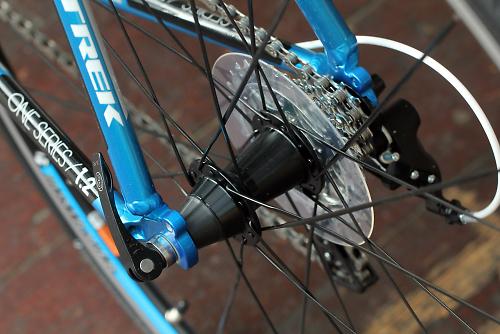
Most of the rest of the kit is no-nonsense stuff from Bontrager too, the handlebar, stem and seatpost being reliable alloy options and the Affinity 1 saddle providing at least as much cushioning as most people will want.
And the compromises
There are no two ways about it, the 1.2's brakes are disappointing. Trek have put the Shimano Sora theme to one side here and specced nameless dual pivot callipers that lack bite. Don't get me wrong, they're consistent and they'll stop you, just not as quickly as you might like. You have to engage the brakes for a bit longer than normal or pull the levers a bit harder to get down to your desired speed.

You adjust to this within a ride or two and don't really think about it until you ride with people who have better brakes on their bikes, or jump back on to a bike with better brakes yourself. Then you're struck by the contrast.
Swapping the brake pads helps, but the bottom line is that these brakes are a compromise to make a price point and, for me, they're the weakest aspect of the entire bike.
Other compromises? There's nothing that really stands out. Trek offer a decent all-round package here.
The Trek 1.2 is a very good bike for the money. The frame and fork are sound, reliable options and the Sora shifters and mechs are better than anything previously available for this kind of cash. They're a great example of the benefits of trickle down technology.
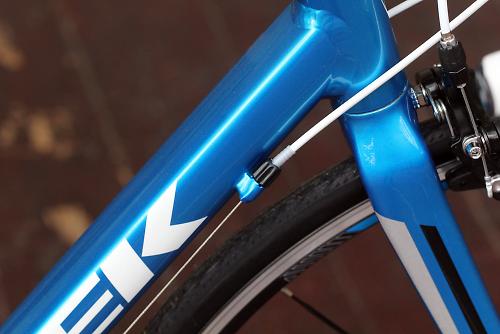
Yes, if you pay a couple of hundred pounds more you'll get a lighter bike that leaps into life more eagerly when you up the intensity for a sprint or tough climb, but that's always the way. As it is, the Trek 1.2 is a very able road bike that'll reward your efforts with decent speed, and it's comfortable enough to ride all day long. The fact that it comes with mudguard and rack eyelets increases its versatility, so you can use it as a year-round workhorse if that's what you're after.
We'd have no hesitation recommending this bike for someone after their first proper road bike, or for anyone else looking for plenty of value.
Very good value, ideal for anyone looking for a first real road bike, with just the brakes as a low point
If you're thinking of buying this product using a cashback deal why not use the road.cc Top Cashback page and get some top cashback while helping to support your favourite independent cycling website
road.cc test report
Make and model: Trek 1.2
Size tested: 58

About the bike
State the frame and fork material and method of construction. List the components used to build up the bike.
Frame 100 Series Alpha Aluminium
Fork Trek carbon road
Sizes 47, 50, 52, 54, 56, 58, 60, 62cm
Front hub Bontrager alloy
Rear hub Bontrager alloy
Rims Bontrager Tubeless Ready
Tyres Bontrager T1, 700x23c
Shifters Shimano Sora, 9 speed
Front derailleur Shimano Sora
Rear derailleur Shimano Sora
Crank FSA Vero, 50/39/30 (triple)
Cassette SRAM PG-950, 11-28, 9 speed
Pedals Nylon body w/alloy cage, toe-clip/strap
Chain KMC X9
Bontrager Affinity 1
Seatpost Bontrager Alloy, 2-bolt head, 27.2mm, 8mm offset
Handlebar Bontrager Race, VR-C, 31.8mm
Stem Bontrager Elite Blendr, w/computer & light mounts, 31.8mm, 7 degree
Headset 1-1/8" semi-cartridge bearings
Brakeset Alloy dual-pivot
Accessories
Bar tape Bontrager gel cork tape
Tell us what the bike is for, and who it's aimed at. What do the manufacturers say about it? How does that compare to your own feelings about the bike?
Trek say: "1 Series aluminium road bikes feature the same aero shaping and race-ready detail as our top-end bikes. They're strong, light, and built to fly over the pavement," [Trek, being from the US, use "pavement" to mean the surface of a road rather than a path].
Frame and fork
Tell us about the build quality and finish of the frame and fork?
It's a tried and tested frame built to a high quality. The same goes for the carbon leg/alloy steerer fork.
Tell us about the materials used in the frame and fork?
The frame is made from aluminium: what Trek call 100 Series Alpha Aluminium.
Tell us about the geometry of the frame and fork?
The 1.2 is built to Trek's H2 geometry that I've explained in the body of the review. Essentially, it's slightly more relaxed than a full-on aggressive race position, but it's still speed orientated.
How was the bike in terms of height and reach? How did it compare to other bikes of the same stated size?
It's a little taller at the front end than a traditional low and stretched road bike.
Riding the bike
Was the bike comfortable to ride? Tell us how you felt about the ride quality.
I found it comfortable both in terms of ride position and ride quality. It's certainly a long way from being a bone shaker.
Did the bike feel stiff in the right places? Did any part of the bike feel too stiff or too flexible?
It's not mega-stiff but it's not too flexy either.
Which components had the most effect (good or bad) on the bike's comfort? would you recommend any changes?
I found the saddle a touch too squidgy for my taste, but I'd rather that than too firm.
In all of these marks, I'm comparing the bike to similarly priced alternatives.
The drivetrain
Wheels and tyres, your summary.
Did you enjoy riding the bike? Yes.
Would you consider buying the bike? It would certainly be on my shortlist if I was after a bike at about this price.
Would you recommend the bike to a friend? I'd recommend it should be on their shortlist too.
Anything further to say about the bike in conclusion?
Nearly all big brand bikes at this price have these features: aluminium frame, fork with carbon legs and alloy steerer, an incomplete Shimano Sora groupset (chainset and brakes being the most frequent omissions), in-house aluminium handlebar, stem and seatpost. If you simply compare spec lists, you'll see that the 1.2 comes out better than some and not quite as well as others.
However, we'd caution against making a decision based solely on a comparison of spec sheets. We've not reviewed all of the 1.2's chief rivals, but we can tell you that this bike will provide you with a very good all-round performance, the brakes being the only real low point.
Overall rating: 8 /10
About the tester
Age: 43 Height: 190cm Weight: 75kg
I usually ride: My best bike is:
I've been riding for: Over 20 years I ride: Most days I would class myself as: Expert
I regularly do the following types of riding: commuting, club rides, sportives, general fitness riding,
Help us to fund our site
We’ve noticed you’re using an ad blocker. If you like road.cc, but you don’t like ads, please consider subscribing to the site to support us directly. As a subscriber you can read road.cc ad-free, from as little as £1.99.
If you don’t want to subscribe, please turn your ad blocker off. The revenue from adverts helps to fund our site.
Help us to bring you the best cycling content
If you’ve enjoyed this article, then please consider subscribing to road.cc from as little as £1.99. Our mission is to bring you all the news that’s relevant to you as a cyclist, independent reviews, impartial buying advice and more. Your subscription will help us to do more.
Mat has been in cycling media since 1996, on titles including BikeRadar, Total Bike, Total Mountain Bike, What Mountain Bike and Mountain Biking UK, and he has been editor of 220 Triathlon and Cycling Plus. Mat has been road.cc technical editor for over a decade, testing bikes, fettling the latest kit, and trying out the most up-to-the-minute clothing. We send him off around the world to get all the news from launches and shows too. He has won his category in Ironman UK 70.3 and finished on the podium in both marathons he has run. Mat is a Cambridge graduate who did a post-grad in magazine journalism, and he is a winner of the Cycling Media Award for Specialist Online Writer. Now over 50, he's riding road and gravel bikes most days for fun and fitness rather than training for competitions.
Add new comment
13 comments.

I'm riding this bike now for over 6 years. Inexpensive when bought for €600. Needed maintenance about 2 years ago which was about €400 (new wheelset, cassette/chain/cabling etc). I've replaced the 700x23-tyres by 700x25-tyres a long time ago without changing anything else. Works like a charm.
Great value for the money but brakes could indeed be better. Meanwhile looking to add a new bike (and use this one solely on the Tacx) with disc-brakes.
- Log in or register to post comments
The current Trek 1 Series bikes have plenty of clearance for fixed mudguards, even with a 25mm tyre. The 2013 1.2 had little clearance, and this was because Trek used the 2 series frame for that particular year. I'm guessing evo_playa has one of these. Agree that SKS Raceblade Long guards are great. The lack of availability is due to a redesign - SKS are developing the new version to allow for bikes with disc brakes. I gather they won't be available until this autumn at the earliest. UK distributors sold out of the old versions months ago.
Seems like a comparable spec and set up to other value bikes. Agree that even low spec bikes are good and has recently made me question my prior choice of 105 or nothing. Anyone know if Claris is any good ? Always found the Trek styling a bit bland but this one looks ok. The latest B twin road bikes seem anazing value if your in the market for a new bike. www.tinpony.co.uk/shop
Tin Pony wrote: Seems like a comparable spec and set up to other value bikes. Agree that even low spec bikes are good and has recently made me question my prior choice of 105 or nothing. Anyone know if Claris is any good ? Always found the Trek styling a bit bland but this one looks ok. The latest B twin road bikes seem anazing value if your in the market for a new bike. www.tinpony.co.uk/shop
The 8 speed Sora front and rear Derailleurs on my Trek are long since worn out and were replaced with Claris just before the winter kicked in. It works really smooth with no problems - even on the old Sora shifters with thumb button.
I've had the 2011 1.1 with shimano 2300 (remember that?) for just over 4 years now, and it certainly scrubs up well. Even with just 2300 and a different wheelset I've raced on it for a couple of years to some success, it certainly doesn't feel like it holds me back, which is very impressive for such a cheap machine. In fact, I like it enough to complete the change to 5700 groupset in the spring.
I can't say I ever had a problem with the brake calipers, and I can't tell the difference between the alloy calipers and the Shimano long drop calipers having swapped them out- they are certainly good enough.
However, I'm not a fan of the H2 fit with the massive head tube- I hate long head tubes and was lucky to get mine before they were introduced.
Excellent winter trainer and commuter. My 2007 Trek 1.2 is still going strong - it's had a few minor changes but still has the Sora 8 speed with thumb button - oh and a pannier rack!
It's still a lovely bike to ride and recommended first road bike.
Not a racing bike. Sit up and beg.
WHY wouldn't they put sensible 25mm tyres on the bike?
Mike T. wrote: WHY wouldn't they put sensible 25mm tyres on the bike?
Quite. I can't really understand why they'd have clearances so tight, seems unecessary. It may be that 25mm tyres would work with some mudguards already mentioned, but probably not full guards that also help keep crud off the chainset especially in winter.
Word of warning though, if it is like my Trek 1.2 with the carbon fork you will be lucky to get a fixed mudguard that fits even though the bike has mudguard eyelets.
Clearance on the front is not good and i had to end up using Crud mudguards for the front wheel.
craigr wrote: Word of warning though, if it is like my Trek 1.2 with the carbon fork you will be lucky to get a fixed mudguard that fits even though the bike has mudguard eyelets. Clearance on the front is not good and i had to end up using Crud mudguards for the front wheel.
As ever, SKS Raceblade Longs. Sorted.
KiwiMike wrote: craigr wrote: Word of warning though, if it is like my Trek 1.2 with the carbon fork you will be lucky to get a fixed mudguard that fits even though the bike has mudguard eyelets. Clearance on the front is not good and i had to end up using Crud mudguards for the front wheel.
Tried quite a few including SKS chromeplastic ones.
edit: tracked them down, looks like instock here : http://www.tredz.co.uk/.SKS-Race-Blade-Long-Mudguard-Set_51833.htm
Fairly simple and inexpensive to swap out the substandard brake calipers.
I upgraded my Trek 1.1 to Shimano non series long drop brake calipers and the difference in braking was amazing.
Latest Comments
It's the job of everyone to use the roads in a safe manner .but you can't be held responsible for others stupidity , riding through red lights,...
The irony here is that by saying this she's showing that she thinks motorists are the actual center of the universe.
People have all but forgotten what a nice place the world can be without cars. They flock to Center Parcs and Snowdon, but never make the...
Coats also seem to cost a lot more these days.
Jamie, that light mount looks great, but there are two problems:...
So Ratboy mentions Froome and Bernal, does he not realise their serious injuries were caused by themselves and not something on the race route?
Yes. Very tasty indeed.
. Another super article, Mat - many thanks. .
I give more credence to the voices of people that build (Ugo.Santalucia and Cycle Clinic used to post extensively on Bikeradar forums, for example)...
Waxing legs is not something I am willing to do ever. Razor or cream 😁
Related Reviews
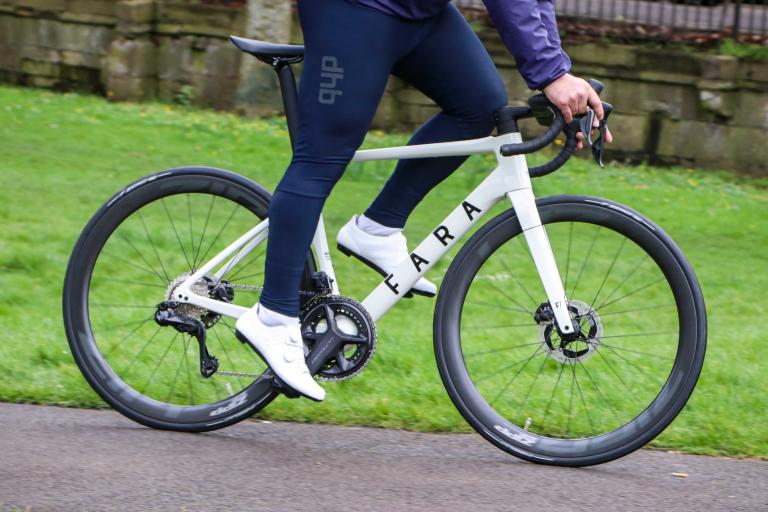
Fara F/Road
Quick, nimble, fun, an impressive ride quality and excellent comfort – and I think it looks stunning
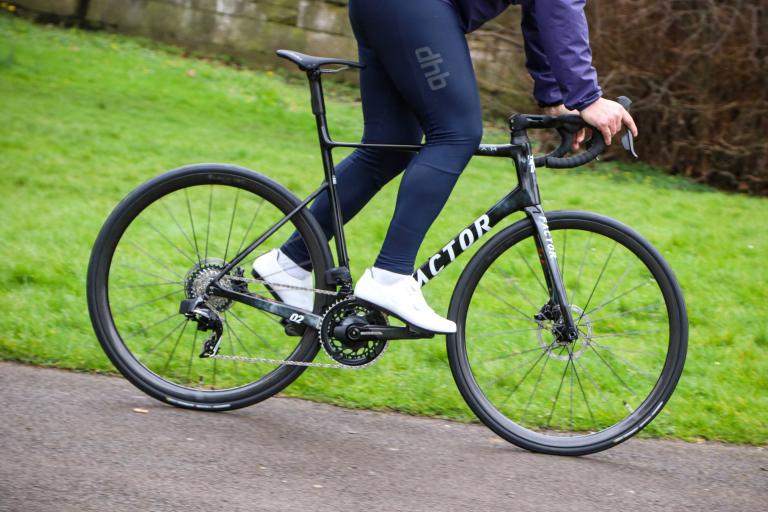
Factor O2 VAM
A master of climbing – but a bike that's also incredible fun and extremely capable everywhere else
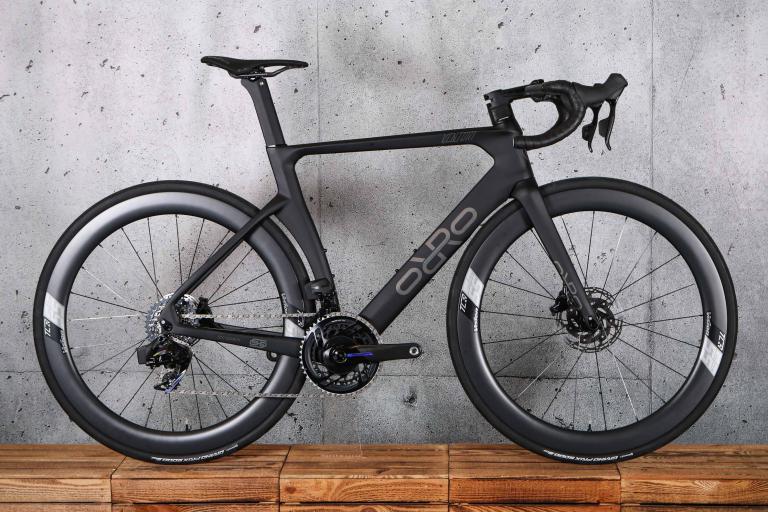
Orro Venturi STC SRAM Force eTap Tailor Made 2024
Real world aerodynamics and well-designed geometry create an excellent bike that is fast and easy to ride

Pearson Forge 2024
Fast and reactive road bike in a regular-rider-focused geometry

Subscribe to my YouTube channel for video reviews.
Trek FX 1 (Disc) Review: Is It a Good Bike or Waste of Money?
CyclistsHub is supported by its readers. We may receive a commission if you buy products using our links.
Trek FX 1 and FX 1 Disc hybrid bikes are often considered by beginners, commuters, and those who want to upgrade their old bike. But the question is, are they worth it?
Based on my overview of the hybrid bike market , comparisons with other brands, and components, the Trek FX 1 is worth it . You’ll especially appreciate its quality craftsmanship, comfortable ride thanks to wider tires, upright riding position, and affordable price.
Continue reading if you want to learn more about this bike, or buy it here (also available with rim brakes ).
Is Trek FX 1 (Disc) a Good Bike?
Trek FX 1 and FX 1 Disc bikes are popular thanks to their affordable price and riding comfort. They retail for $599 and $699, respectively (in 2023).
They are available in multiple sizes (FX 1: S-XL, FX 1 Disc: XS-XXL), pleasing many riders.
You can also choose from two colors that change with each new generation. Trek also usually equips them with slightly modified components every year.
Another great news, especially for women, is that Trek FX 1 and FX 1 Disc are available as step-through options, making it easier to get on.
Pros and Cons of Trek FX 1 and FX 1 Disc
Here, I summarized the pros and cons of Trek FX 1 and FX 1 Disc.
Pros of Trek FX 1 and FX 1 Disc
- Quality and sturdy aluminum frame
- FX 1 Disc has excellent stopping power thanks to disc brakes
- Available for men and women
- Excellent price-value ratio
- Comfortable geometry, allowing upright riding position
- Ergonomic grips for relieving pressure on your wrists
- Compatible with racks and fenders
- Flat pedals included
- Compatible with DuoTrap S sensor
Cons of Trek FX 1 and FX 1 Disc
- 3X drivetrain (2X and 1X became more popular thanks to their simplicity)
- Slightly heavier
To fully understand the pros and cons, I recommend reading the following section, where I compare its features with today’s hybrid bikes .
Main Features of Trek FX 1 and FX 1 Disc
Let’s now dive deeper into Trek’s FX 1 and FX 1 Disc components so you better understand their value.
Aluminum Frame
One of the main features of every bike is its frame. All Treks FX 1 and FX 1 Disc were based on an aluminum frame.
Aluminum frames are durable, reasonably lightweight, and affordable. That’s why aluminum is still one of the most popular bike frame materials .
Their fork is made of steel, though. This means a weight increase and a little worse aesthetics as the fork doesn’t match the rest of the bike. But, function-wise, you can rely on it.

The geometry of FX bikes is a bit more aggressive than other hybrid bikes for around $500 but still relaxed enough for an upright riding position.
This means you won’t experience back pain after long rides, and you don’t need to be as flexible as you would on high-performance road bikes, for example.
700c Wheels
Trek FX 1 and FX 1 Disc have 700c wheels that are standard on hybrid and road bikes.
They come with 35mm hybrid tires, ensuring you can ride fast on paved roads, but they won’t puncture once you enter gravel.

These tires are one of the main reasons these bikes are so versatile. Of course, we are not talking about an MTB-like terrain but rather a compromise between road and gravel biking .
Trek FX bikes come with Shimano and Tektro components (drivetrain and brakes). The 3X drivetrain is one of the main weaknesses of these bikes. I know you will have more gears, but let me explain.
From my experience, most people often don’t know how to shift properly and often encounter cross-chaining.
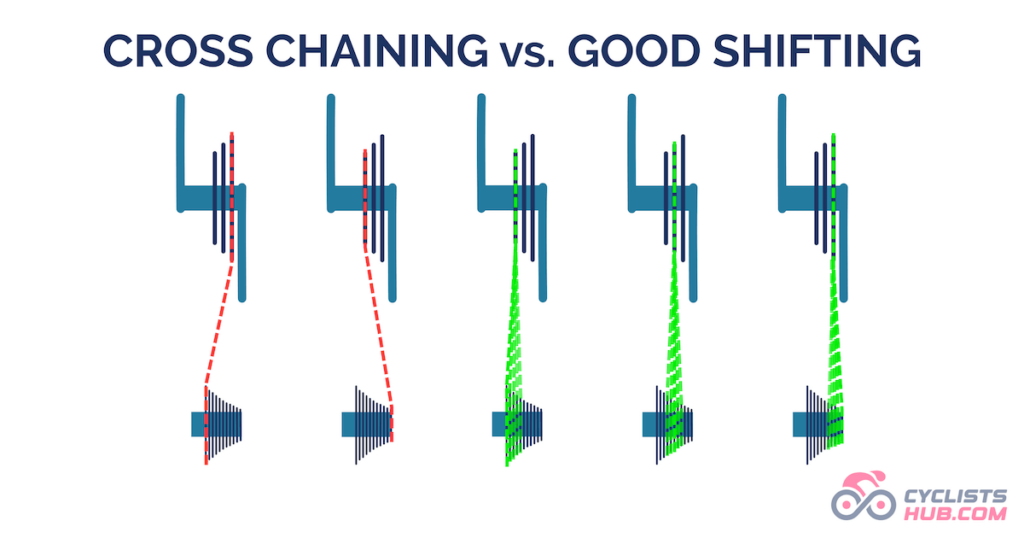
That’s why I believe 2X and 1X drivetrains are better for beginners and less experienced riders.
They are simpler to use and maintain. Furthermore, they are lighter. 3X drivetrains are too complicated.
Other components, like the saddle, seatpost, handlebar, stem, etc., were made by Trek’s brand Bontrager.
The 3×7spd drivetrain on FX 1 offers 21 gears, and FX 1 Disc has 3×8spd (24). That’s a lot. I have 22 on my road bike ( modern road bikes have 24).
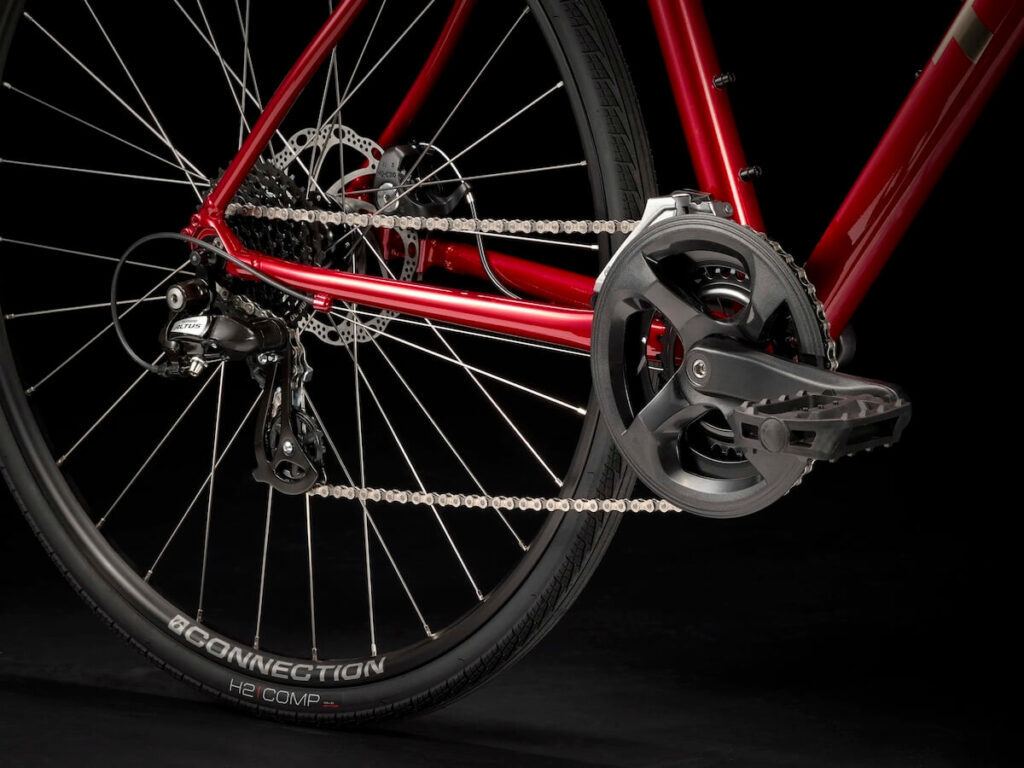
The gear ratios (i.e., the gears’ difficulty) range from easy gears suitable for steep climbs up to hard gears for fast descents.
Remember, FX 1 and FX 1 Disc gear ratios are slightly different. But you should be fine with both whether you live in a flat or hilly area.
Trek FX bikes come with a couple of extra features that are worth mentioning. First, they have ergonomic grips that reduce pressure on your palms. So, even if you ride without gloves, your hands won’t get sore.
Furthermore, FX bikes are compatible with the DuoTrap sensor. While not included with the bike, if you decide to get it, it will measure your cadence, speed, and distance ridden.
Of course, these bikes are also designed to be compatible with fenders, stands, and racks to increase your storage capacity.
Trek FX 1 and FX 1 Disc Specifications
Below, I summarize the most important technical specifications.
- Frame material: Aluminum
- Fork material: Steel
- Weight: ±13 kg (28.7 lbs), depending on frame size
- Wheel size: 700c
- Brakes: Rim or disc
- Groupset: Shimano Tourney/Altus
- Gears: 3×7spd, 3×8spd (14-34T or 11-32T cassette)
- Colors: Differ based on the year
The following pictures show the detailed specifications of the Trek FX 1 and FX 1 Disc.

Trek FX 1 and FX 1 Disc Alternatives
One of the closest alternatives to the Trek FX family are the Co-op CTY bikes , especially the CTY 1.1 and CTY 1.2.
Eventually, you can check out bikes like Marin or Polygon or:
The hybrid bikes Trek FX 1 and FX 1 Disc aren’t perfect – no bike is. However, they offer a good price-value ratio.
They will reliably serve you whether you want to use them for commuting to work or maintaining your fitness.
They allow you to ride on asphalt, paved paths, bumpy roads, and even on terrain like dirt roads or light gravel.
So, which one will you choose? Personally, I would lean towards the FX 1 Disc version for its excellent stopping power.
Trek FX 1 and FX 1 Disc FAQ
Trek FX 1 and FX 1 Disc hybrid bikes are worth it, especially if you buy them discounted. They are ideal for beginners and those looking for an affordable and reliable bike for commuting.
Trek FX 1 weighs 12.57 kg (27.72 lbs), and the FX 1 Disc is 12.68 kg (27.96 lbs) in the M size.
Trek FX 1 (Disc) is the base model of the FX family. Higher-end models have better components, resulting in a lower overall bike weight. Check out my Trek FX bikes comparison for more info.
About The Author
Petr Minarik
2 thoughts on “trek fx 1 (disc) review: is it a good bike or waste of money”.
I have a 2024 v brake trek fx1 and i love it. Its probably the best bike I’ve ever had. Don’t like the mechanic at the shop I bought it from but I’ll definitely buy another trek bike if I could ever afford it. This thing glides. Love it. Somehow my rear v brake is spongy right after a break in adjustment and brake tune. Still figuring that out.
Cool. I am glad you enjoy it. 🙂 What do you mean by “spongy”? – Petr
Leave a Comment Cancel Reply
Your email address will not be published. Required fields are marked *
Save my name, email, and website in this browser for the next time I comment.
Start typing and press enter to search
Trek 1.5 road bike review
The Trek 1.5 is designed to be solid and dependable option for the new road cyclist, that will feel equally at home on a commute as a long Sunday ride
- Sign up to our newsletter Newsletter
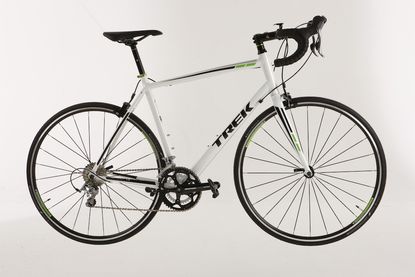
If you are looking for a first road bike or solid winter steed, this is a quality frame that will last the course and not let you down. The geometry is very relaxed, with this bike better suited to all day comfort and less flexible riders. The ride is smooth, but the brakes and a couple of other minor details let the overall package down when we consider the price.
Smooth ride
Accelerates well
Tiagra shifting is good
Tubeless ready rims
Lifetime warranty on the frame
23mm tyres not 25mm
No 32t cassette
Boring styling
You can trust Cycling Weekly. Our team of experts put in hard miles testing cycling tech and will always share honest, unbiased advice to help you choose. Find out more about how we test.
Trek frames are synonymous with quality and their faith in the product is backed up by life time warranty. The frame is Trek's top drawer 'Alpha aluminium' whilst the fork is carbon fibre. In order to test the Trek 1.5 we have been riding it throughout winter, on commutes and longer training rides.
>>> The best cheap road bikes ridden and rated
The One series is Trek's base level frame and would potentially suit a large number of cyclists. If you are in the market for your first road bike, a dependable winter bike, or just something for epic sportives that won't break the bank, the Trek 1.5 is a great option. Hinting at this versatility is the inclusion of eyelets on the stays and forks, to aid the fitting of mudguards. There is also loads of mudguard/tyre clearance under the brakes. But, if you are flexible, or have good core strength you may find the upright posture this bike encourages limiting when you want to get lower and more aero.

Geometry
The geometry of the Trek 1.5 is relaxed. For those new to cycling, this means that the horizontal reach from the saddle to the handle bars is shorter and the vertical height of the handle bars is higher. Rather than a super aggressive flat back like Bradley Wiggins , this enables the rider to sit more upright, in a more relaxed position.
This makes it ideal for new riders, who are yet to develop the core strength and flexibility that makes an aggressive position more sustainable. Our 58cm test model came with 44cm bars, which although less aerodynamic than a narrower bar, they may help add stability to overall handling to less confident riders.
>>> Complete buyer's guide to road bike groupsets
The Trek 1.5 comes fitted with a range of components. The shifters and derailleurs are Shimano Tiagra , but the chain set is FSA Vera and the brakes are unbranded callipers. We were hugely impressed with the quality of the shifting on this bike. The FSA chainset works well in this regard with little or no flex, to hamper shifts.
We felt that the brakes let the bike down. The unbranded callipers didn't feel as responsive or stable as a Tiagra or Shimano 105 calliper. The lack of strength translates to less braking power and compromised modulation. That considered, the first thing we would upgrade on this bike would be the brakes. This is disappointing when we consider the overall price.
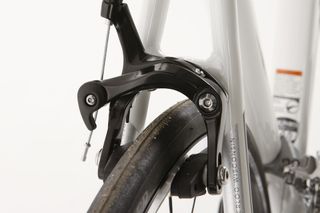
Our test model featured 23mm Bontrager R1 tyres. These rolled nicely and were puncture free for over a few weeks of winter riding and commuting on roads strewn with potential puncture hazards. We would have preferred to see this bike come fitted with 25mm tyres as they are stronger and can aid comfort. We do however like that Trek have equipped the bike with tubeless ready rims . Using tubeless tyres could reduce the risk of punctures.
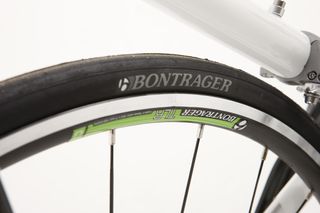
>>> Guide to road bike tyres
The Tiagra rear cassette is 12-30t. With professionals even adopting 32t cassettes on steep mountainous days, it would be nicer if the Trek came with either a 12-32t cassette or a medium length cage rear derailleur, which would allow a 32t cassette to be fitted. Being a short cage derailleur, it is designed to only go up to 30t. This is in contrast to other bikes in a similar price range, such as the Giant Defy 3 and B'Twin Alur , which both have 32t cassettes as standard.
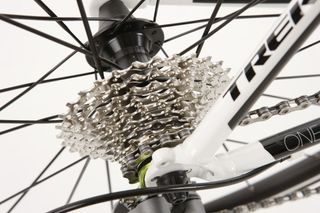
Ride and handling
Our favourite thing about the Trek 1.5 is the ride handling. Use of round tubes helps contribute to stiffness, whilst the carbon fork offers some dampening. The ride is very smooth, with the frame doing an excellent job of ironing out imperfections and bumps. Considering how well the frame absorbs road buzz we were pleasantly surprised to find that the bike is no slouch when you want to accelerate out the saddle either.
Compliant frames can often feel spongy when you give it the beans, but the Trek 1.5 quickly gets up to speed without any fuss. Wheels on bikes in this price range can often be bargain basement, with spokes that feel as if they are made of cooked spaghetti, but we were pleasantly surprised by the Bontrager wheels on this bike. They compliment the frame well and don't sacrifice ride quality.
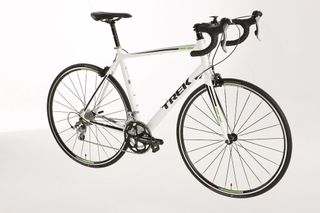
Overall, the bike feels nicely balanced, with the weight centred. This is noticeable when riding uphill or track standing. Our 58cm test weighed in at a respectable 8.7kg without pedals. Cornering can feel a little tame, but will always be the case when a bike has a high front end. A lower front end enables you to lower your centre of gravity to a greater degree.
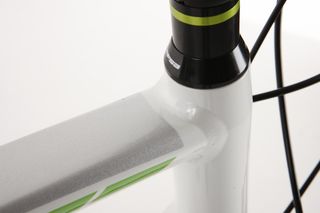
Whilst colour is subjective, we feel the Trek is rather boring to look at. The first thing that draws your eye to a bike is the way it looks and the Trek looks pretty utilitarian. Don't expect to cop admiring glances at the cafe stop. That said, plenty of us value function over form.
For more information, head over to Trek .
Thank you for reading 20 articles this month* Join now for unlimited access
Enjoy your first month for just £1 / $1 / €1
*Read 5 free articles per month without a subscription
Join now for unlimited access
Try first month for just £1 / $1 / €1
Get The Leadout Newsletter
The latest race content, interviews, features, reviews and expert buying guides, direct to your inbox!
Oliver Bridgewood - no, Doctor Oliver Bridgewood - is a PhD Chemist who discovered a love of cycling. He enjoys racing time trials, hill climbs, road races and criteriums. During his time at Cycling Weekly, he worked predominantly within the tech team, also utilising his science background to produce insightful fitness articles, before moving to an entirely video-focused role heading up the Cycling Weekly YouTube channel, where his feature-length documentary 'Project 49' was his crowning glory.

The Visma-Lease a Bike rider was set to ride the Italian Grand Tour for the first time
By Adam Becket Published 11 April 24

'I must be as good as I once was' is not a reliable maxim when it comes to long rides, it seems
By James Shrubsall Published 11 April 24

Second at Paris-Roubaix Espoirs, just a year after his career was almost cut short, the young Brit is ready to turn pro
By Tom Davidson Published 11 April 24
Useful links
- Tour de France
- Giro d'Italia
- Vuelta a España
Buyer's Guides
- Best road bikes
- Best gravel bikes
- Best smart turbo trainers
- Best cycling computers
- Editor's Choice
- Bike Reviews
- Component Reviews
- Clothing Reviews
- Contact Future's experts
- Terms and conditions
- Privacy policy
- Cookies policy
- Advertise with us
Cycling Weekly is part of Future plc, an international media group and leading digital publisher. Visit our corporate site . © Future Publishing Limited Quay House, The Ambury, Bath BA1 1UA. All rights reserved. England and Wales company registration number 2008885.
Cycling made Simple.
Made By Cyclists
Trek Alpha 1.2 Review
February 9, 2023
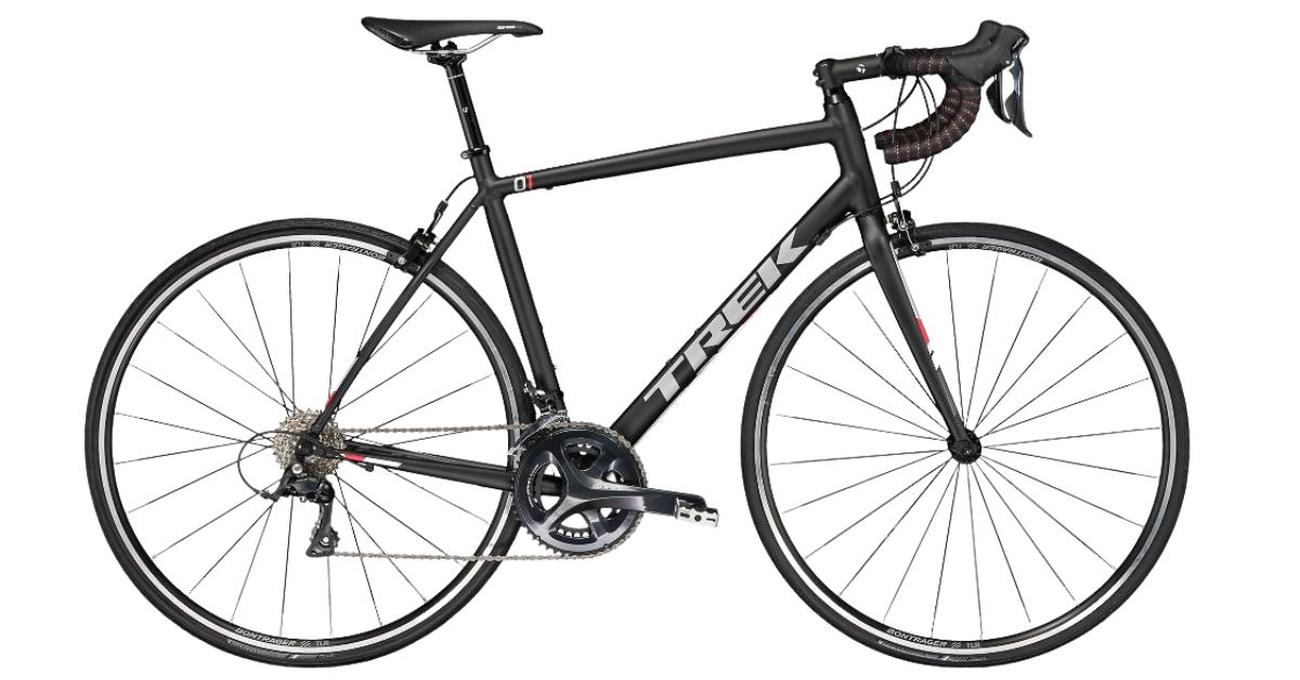
Key Takeaways
- The Trek Alpha 1.2 is a decent entry point to mountain and trail biking.
- The components are reliable, but won’t set any records.
- Handling and ride quality are serviceable, but braking is a major downside to this bike.
- Experienced riders will notice a bouncier ride and less responsive shifting.
This article may contain affiliate links where we earn a commission from qualifying purchases.
This bike may not win any awards, or be able to compete with pricier models, but this could be a good first mountain bike if you’ve never ridden one before.
The Trek Alpha 1.2 is a budget-friendly option that utilizes the brand’s quality components in most areas. There may be some compromises considering the more specialized options out there, but rest assured that despite its flaws this bike is no slouch.
We’ve looked at the most-reviewed features (including the negatives as well as the positives) to bring you the best info available on the Alpha 1.2.
TABLE OF CONTENTS
Where to Buy the Trek Alpha 1.2
The Trek Alpha 1.2 costs $959, and can be purchased directly from the Trek website .
A Brief History of Trek Bicycles
Trek was founded in the 1970s, attempting to penetrate the high-end market that had up until that point been dominated by European makers. It quickly gained a reputation for quality, with a foundation on hand-built steel frames.
However, launching its own factory in the 1980s meant that it also had to keep with the times, which meant a shift to aluminum frames. It also meant the advent of hybrid bikes, which combined the best of mountain bikes and road bikes into one line. The next decades led to several brand acquisitions and consistent recognition in the marketplace for excellence in quality and performance.
Trek’s Bontrager line of accessories is also a gold standard for those wanting to customize their bikes. They also held a long-standing licensing agreement to produce LeMond bikes, a prominent brand in speed racing (although this brand has since been discontinued).
Trek Alpha 1.2 Specs and Geometry
The Alpha 1.2 has had several iterations over time, which means that although it is a budget-friendly option, it has had the chance to improve over time. Trek does a good job of incorporating research and features from its higher-end bikes on down the spectrum, and the Alpha is no exception. It benefits from the quality parts Trek has built its reputation on over the decades.
The Alpha 1.2 weighs 21.5 pounds. This is a lighter bike for sure, which (in addition to a price point under a thousand dollars) makes this a great starting point for riders that are exploring mountain and trail riding but don’t want to break the bank just yet.
This lighter bike weight does mean that the overall weight capacity is slightly lower. The total capacity (which includes the bike itself, the rider, and all equipment and accessories) is 275 pounds. This may not cause problems for the majority of riders, but if you plan on bringing any kind of gear with you on the trail, you will want to think carefully about what you bring along.
The handlebars are not curved, which can make it easier to bring them back to a straight-forward position. This is a benefit to those who might not be used to a curved setup, although it does have some limitations for more experienced riders and may be a less comfortable position on longer rides.
The price point and equipment set does put this bike at the lower end of the spectrum when it comes to quality and all-around excellence. This does not in any way diminish the many positives of this bike; but when set next to its bigger and more expensive counterparts, it lacks some luster and looks appropriately less outstanding by comparison.
There are seven different sizes to choose from, making this a versatile choice no matter what size you may be. A little planning and research gives you the perfect fit for your personal size.
Trek Alpha 1.2 Build Quality
We hesitate to return to the term “affordable” too often, but it does come into play when thinking about the build quality and included components. It is affordable in most senses of the word, and while that does not mean the quality is poor, you could do better by shelling out a few extra dollars and going with a more premium model.
Like many Trek bikes, the Alpha 1.2 features an aluminum frame. This lends to the overall lighter weight, and sets it in great company with its Trek brethren as sturdy bikes that will hold up to whatever Mother Nature can dish out.
The frame does rise at the front end, which does create a more comfortable upright riding position. This is a simple tweak that seasoned riders will appreciate, and can provide a helpful learning experience if it’s your first time on the trail.
As with other elements of the bike, the fork is also lightweight, which makes handling a bit easier to manage
The drivetrain assembly features a 2x9 setup, allowing for low and high shifting at any speed. This is a perfectly reliable option that adds a welcome layer of control for those who want to get the most out of their performance.
That being said, it is a slightly less specialized version than the one found in the road-going bike. This is one area where Trek may not have cut corners, but has instead opted for a less premium setup that shows in what results from the sum of its parts.
The pedals, however, seem to be of higher quality than can be found on other budget bikes. The various pieces will hold up well over time, and offer an easy pedaling experience. This is a positive that may seem simple, but is invaluable while out on the track.
Trek Alpha 1.2 Handling
The lightweight frame does cause some roughness in the ride. It may not absorb all of the shocks and bumps that come from rough terrain, but the ride quality is not diminished in such a way as to render it a miserable experience.
Over calmer terrains, the lighter tires do create a smooth ride. They are 25 millimeters wide, which is narrow by most standards but perfectly serviceable on this bike.
The Alpha 1.2 does accelerate well for its class. Easy pedaling and solid speed control create a fun experience on steady trails and uphill climbs.
The main downside to higher speed is that the brakes leave something to be desired. The brakes are a dual-pivot design, which is nowhere near as effective as hydraulic disc brakes. This is a major pitfall, and can especially cause problems if you have trouble managing your speed on downhill grades.
Overall, however, the handling and ride position does create a balanced seat for the rider. You can be confident in your control of the bike, and in how you can respond to your surroundings.
Trek Alpha 1.2 Ride Quality and Performance
One other complaint related to the ride quality is that the seat can be hard. This component is fairly easy to customize, however, and it may be worth looking into this if you plan to keep this bike for any length of time.
While the lighter tires do make it a capable performer in turns and straights, they can cause some wobble over trickier patches. Use extra caution when going over gravel or rockier areas, as the lighter tires will show their shortcomings if you’re not careful.
Climbing and Descending
It isn’t the fastest climber of the bunch, but it gets the job done. There’s plenty to like about this bike, even if it won’t set any records flying uphill.
What it lacks in uphill speed, it more than makes up for on the downhill push. But as we’ve noted, that’s not always a good thing. Keep your wits about you, and be ready to pay extra attention to brake management so you don’t spin out of control.
Trek Alpha 1.2 Pros and Cons
Trek alpha 1.2 pros.
The Alpha 1.2 makes the most of its Trek brand reputation, and leans heavily into the components it has built its name upon.
It is a lighter bike than others at higher price points, with the trademark aluminum frame that Trek is known for.
Setting the handlebars in a more straight configuration may turn away some trail-riding veterans, but this can lend itself to a stable and reliable ride for those who need to log more hours on the trail.
The acceleration is reliable enough, and the ride position will make anyone comfortable on straight tracks and uphill climbs.
- Brand reputation and overall quality
- Light weight
- Aluminum frame
- Straight handlebars
- Reliable acceleration
- Solid handling and comfortable riding position
Trek Alpha 1.2 Cons
The Trek Alpha 1.2 does come at an affordable price point, but it does follow that the components and build quality will be slightly lower than other bikes.
The drivetrain is less specialized, and while that may not mean much to some, it can turn away other riders who may want that level of control.
It does feature a rougher ride due to its lighter weight, and the lighter tires also take away some stability. It may be fine on steady tracks, but when the going gets tough you may want to think about upgrading in certain areas.
One area you don’t want to skimp on when upgrading this bike is the brakes. Look into how you can best fix this shortcoming by choosing new brakes after purchasing, or decide if it’s worth choosing a different bike altogether.
- Lower overall quality when compared to premium models
- Less specialized drivetrain
- Rougher ride due to lighter frame
- Lighter tires are less stable
- Braking leaves much to be desired

Why Road Cyclists Are Switching to Gravel Bikes

Why Fitness Enthusiasts Are Switching to Smart Cycling Trainers

Why Competitive Cyclists Are Switching to Aero Road Bikes

Why Eco-Conscious Riders Are Switching to Bamboo Bikes
About THE AUTHOR

Danny Lawson
Mountain biking is more than just a hobby for me - it's a way of life. I love the challenge and excitement that comes with it, and I'm always pushing myself to go faster and ride harder. Some people might think that mountain biking is dangerous, but I see it as the only way to live.
Trending Now

Why City Dwellers Are Switching to Folding Bikes

Why Budget-Conscious Riders Are Switching to Co-op Bike Brands

Why Mountain Bikers Are Switching to Fat Tire Bikes

Why Urban Commuters Are Switching to Electric Bikes

About PedalChef
PedalChef is a blog on all things cycling. We are a group of people who love bikes, and we want to share the joy that comes with the experience. You can read more about us here .

©2024 PedalChef. All rights reserved.
We can be reached at [email protected]
PedalChef.com is a participant in the Amazon Services LLC Associates Program, an affiliate advertising program designed to provide a means for sites to earn advertising fees by advertising and linking to Amazon. This site also participates in other affiliate programs, and is compensated for referring traffic and business to these companies.

- Rider Notes
2016 Trek 1.1 H2 Compact

An aluminum frame race bike with mid-range components and rim brakes.
For This Bike
View more similar bikes →
A bike with lower gearing will be easier to ride up steep hills, while a higher top end means it will pedal faster down hills.
1.1 H2 Compact
Similar Bikes
(descending)
Add custom gearing
4'11" – 5'3"
5'1" – 5'5"
5'3" – 5'7"
5'5" – 5'9"
5'7" – 6'0"
5'10" – 6'2"
6'0" – 6'4"
6'2" – 6'5"
🐐 Estimated
Do you have this bike? Help other riders make a decision about which size will work for them by sharing your own size and fit notes. Report your fit
May 2017 · Rupert Radley
The Trek 1.1 is Trek's bottom rung road bike, but that doesn't mean budget ride quality
Comfortable ride
Carbon fork
Tubeless ready wheels
Pannier rack/mudguard compatible
Brakes could be better
Read Review

Last updated June 29 Not listed for 2,477 days
- MAGAZINE OFFERS
- BIKE INSURANCE
- Best Products
- Maintenance
- Accessories
- Long-Term Reviews
- BikeRadar Podcast
- First Look Friday
- Bike of the Week
- Tech Features
- Routes and Rides
- Bike Galleries
- BikeRadar Bargains
- Buyer's Guides
- Fitness & Training
- Sizing & Fit
- Mountain Biking UK
- Cycling Plus
Trek 1.5 review
Build your road confidence
Joby Sessions
Guy Kesteven

Trek haven’t changed their entry-level road frame much for the past couple of years, but there are plenty of riders who want ‘sit up and beg’ comfort and relaxed handling in a road bike style, so there’s no reason they should. It wouldn’t be our first choice for more competitive work though.
Ride & handling: Comfortable enough for long rides and ideal for building confidence
There’s a fair amount of sideways flex in the Trek 1.5's tall head tube and narrow-stance fork if you bully rather than coax the steering. Starting with a downer on one small aspect of the handling is slightly unfair though, as the rest of the ride is unfailingly friendly and easy to live with.
Even Trek’s race bikes have a reputation for being more relaxed and surefooted than others and with a higher bar position and more centralised weight the 1.5 is even less threatening on descents or twisty lanes. High levels of vibration absorption in the slim, tall tubes reduce the chatter and ragged traction effect that can throw you off-line in rough conditions.
The tall cockpit height and shallow handlebar create a comfortable position when your hands are hooked into the more secure position of the drops, making the Trek a great confidence builder for those who don’t generally like to push their trust in tarmac traction. More accessible hand positions and the impressive amount of comfort for a mid-price alloy frame also make the 1.5 a welcoming place to be when you’re heading into work or putting in the long miles at the weekend.
The upright position means plenty of breathing space too, which, combined with the low complete bike weight and the extra-large rear cog on the cassette, means it cruises up steep hills surprisingly easily. Start applying pressure though and it’s less convincing. Flex from the crankset combines with a soft overall feel from the chassis – particularly when bracing bar against pedals – to take the edge off your effort before it reaches the road.
The upright position that saves your spine from too much strain but also prevents you from really putting your back into it or escaping from headwinds when you need too. However, keep your pedal revs high and your pedal pressure down and it’ll spin along quite happily. If you do use it for racing, you’ll find the fatigue reduction during the ride a bonus when you get to the run.
Chassis: Simple but relatively lightweight frameset builds a similarly light bike
Trek base the 1.5 around their H2 geometry, a higher fronted, more upright version of their H1 competition positioning. That’s the reason behind the very tall, slim head tube which is increased in effective height even further by the deep external cups of the FSA Intellaset headset on this build. Quite what extra intelligence it adds we weren’t able to confirm, but it certainly gives the bike a high brow.
There doesn’t seem to be much elaborate thinking in the tube shapes, with a round-to-straight top tube and only very slight shaping on the down tube. The D-section-to-round chainstays and oval-to-round seatstays finish at plain chunky dropouts, although the pearl and blue-black paint finish adds a dash of decorative class.
While Trek haven’t gone overboard on the external detailing or tube shaping, frame weight is still perfectly reasonable thanks to unseen butting that removes excess metal from the tube walls. Utility use is definitely still on the agenda though, and commuter use is certainly possible with rack and guard mounts at the rear and mudguard eyes on the slim crowned, carbon-legged fork.
Equipment: Square-taper crankset is a disappointment at this price
It seems that the £800 bike club is operating a strict “if you ain’t wearing Shimano Tiagra, you ain’t coming in” door policy this year. While the Trek will get past the bouncers outside, a close look at the FSA Vero compact chainset makes entry through the component ‘velvet rope’ less likely. While square-taper internal bottom brackets tend to last well, they’re also prone to more creak, flex and eventual removal trauma than external cups are.
There’s loads of mudguard/fat tyre clearance under the deep drop brakes though, and cartridge pads keep them reasonably sharp in feel despite the longer arms. While the ride position is far from aero, the Bontrager rimmed wheels get fashionable bladed spokes. They also use a new Clix skewer system and the front hub uses a larger than normal cam offset and a big locking collar, which means no more messing about with skewer wind-on/wind-off, which is great for cold-fingered puncture fixing or new riders. The ‘Plus’ puncture protection on the Bontrager R1 tyres should mean flats are less likely in the first place, though.
The Bontrager Approved gear is the lowest grade of named components, but it all does a decent job. The shallow compact bend makes the dropped section on the handlebar more useable but the long stem doesn’t have an entirely positive effect on handling – it has a tendency to lurch around at really slow speeds, so be careful if you’re chasing your tail on a quick turnaround.
Share this article

- Terms & Conditions
- Subscribe to our magazines
- Manage preferences

Trek FX 1 Review
Are you in the market for a new bicycle but feeling overwhelmed by the countless options available? Look no further!
In this article, we will be reviewing the Trek FX 1, a popular choice for both beginners and experienced cyclists alike.
Finding the perfect bicycle can be a daunting task, with so many brands and models to choose from.
The Trek FX 1 has gained a reputation for its versatility and reliability, making it a top contender in the market.

But is it really worth the hype? Let’s dive into the details and find out.
When it comes to purchasing a bicycle, it’s important to consider your specific needs and preferences.
The Trek FX 1 offers a range of features that cater to various riding styles and terrain conditions.
Whether you’re a casual rider or a fitness enthusiast, this review will provide you with all the information you need to make an informed decision about the Trek FX 1.

– Lightweight and durable frame: The Trek FX 1 features a high-quality Alpha Gold Aluminum frame that is both lightweight and strong, ensuring a smooth and stable ride.
– Versatile and comfortable design: With a relaxed geometry and a wide range of gearing options, the FX 1 is designed to provide a comfortable and efficient ride on a variety of terrains.
– Reliable braking system: The FX 1 is equipped with powerful and reliable Tektro linear-pull brakes, providing excellent stopping power in all weather conditions.

– Convenient and practical features: The bike comes with rear rack and fender mounts, allowing you to easily carry your belongings and stay clean and dry during your rides.
– Easy and intuitive gear shifting: With a simple and reliable Shimano 3×7-speed drivetrain, the FX 1 offers smooth and precise gear shifting, allowing you to easily tackle hills and adjust your speed.
– Comfortable and ergonomic handlebars: The bike features a flat handlebar design that provides a comfortable and upright riding position, reducing strain on your back and shoulders.
– Trusted brand: Trek is a renowned brand in the cycling industry, known for producing high-quality and durable bikes that are built to last.

8 Best Gravel Bikes Under $500

The Best Flat Bar Gravel Bikes Of 2023

Best Bike for Long Distance Touring | Should I Buy a Touring Bike?

One of the standout features of the Trek FX 1 is its lightweight Alpha Gold Aluminum frame.
This not only makes the bike easy to maneuver, but it also provides the durability needed to withstand the rigors of daily use.
The frame geometry is designed to promote an upright riding position, ensuring maximum comfort and reducing strain on your back and neck.

The FX 1 is equipped with a Shimano 21-speed drivetrain, giving you a wide range of gears to choose from.
This allows you to easily tackle hills and adjust your speed to match the terrain.
The Shimano components ensure smooth and reliable shifting, so you can focus on enjoying your ride without any mechanical hiccups.

Another noteworthy feature of the Trek FX 1 is its puncture-resistant 700x35mm Bontrager H2 Comp tires.
No one likes dealing with a flat tire in the middle of a ride, and these tires help minimize that risk.
They provide a good balance between grip and rolling resistance, ensuring a smooth and stable ride on both paved roads and light trails.

Versatility
The FX 1 also comes with a variety of convenient features.
It has mounts for racks and fenders, making it easy to add accessories for commuting or touring.
The bike is also compatible with a wide range of accessories, such as lights and bike computers, allowing you to customize it to suit your needs.

In terms of comfort, the Trek FX 1 doesn’t disappoint.
It features a Bontrager Sport saddle that provides ample cushioning and support, even on longer rides.
The ergonomic grips help reduce hand fatigue, while the adjustable stem allows you to find the perfect riding position.
Overall, the Trek FX 1 is a reliable and versatile bike that offers great value for its price.
Whether you’re a beginner cyclist or an experienced rider, this bike is sure to meet your needs.
With its lightweight frame, smooth shifting, and comfortable ride, the FX 1 is a solid choice for anyone looking to hit the road or trail.
Order yours online today and pick it up at your local Trek store, or have it delivered to your home!

Trek FX 1 Disc Review

2023 Trek FX Sport 4 Review

2023 Trek FX+ 2 Electric Bike Review
Other popular bikes.
- 5 Great Bicycle Alarms | Do you need one?
- Electra Townie Go! 7D Step-Over Electric Bike Review
- 2023 Cannondale Habit LT 2 Review
- Salsa Journeyer Claris 650b Review
- Lectric eBikes XP 3.0 eBike Review
Related Posts

Vitus Sentier 29 VRS Mountain Bike Review

Kona Libre Review

Bombtrack Arise SG Gravel/All-Road Bike Review

Cannondale Trail 6 Review

IMAGES
VIDEO
COMMENTS
Trek 1.1 review. The Trek 1.1 is Trek's bottom rung road bike, but that doesn't mean budget ride quality. ... The frame itself is made from 100 series Alpha Aluminium, which happily brings a ...
The emergence of smaller bike companies pushed Trek to drop Alpha 1.1 in favor of other lines, such as the FX series or the Emonda lineup. At about the same time, Trek and Segafredo partnered to sponsor an International Racing Team. In 2022, the team has over 31 riders on the men's side and 14 riders on the women's.
The Trek 1.1 builds the frame with an Alpha Aluminum 100 Series for a more compliant frame, allowing the Trek 1.1 to maintain gold-hot acceleration performance at an affordable price. ... The Trek 1.1 uses a headset with 1-1/8″ integrated, semi-cartridge bearings. ... Learn more: Schwinn 700c Prelude Road Bike Review. Fuji Jari 2.5 vs Trek 1. ...
The Trek 1.1 is Trek's bottom rung road bike, but that doesn't mean budget ride quality ... Brakes could be better. Read Review. Geometry. Specs. Build. Frame: 100 Series Alpha Aluminum, fender & rack compatible. Fork: Trek carbon road. Bottom Bracket: Sealed cartridge. Headset: 1-1/8" integrated, semi-cartridge bearings. Stem: Bontrager Elite ...
Trek 1.1 review - BikeRadar
5. ★★★★★. ★★★★★. Strength: The frame is great value for money, and the components won't leave you feeling let down. The handling is good for beginners, not too snappy to make for a twitchy ride but still responsive enough to have lots of fun with- goes where you want it to. Frame reasonably comfortable for an alloy frame ...
2011 Trek. 1.1. An aluminum frame race bike with mid-range components and rim brakes. ... 1.1 rider review. Aug 2023 · Titus Jordan Sarasota FL (Glow) Titus Jordan Sarasota Strava ... group set / but what do you want for over 10yrs old. Read Review. Specs. Build. Frame: Alpha White Aluminum. Fork: Aluminum. Headset: 1-1/8" semi-integrated ...
This is a brief review on the trek 1.1 road bike. 2013 update great beginners road bike and afordable price. Thanks for watching and I appreciate it.Visit my...
A brief review of my Trek 1.1 road bike. Aluminum Alpha 100 series frame with carbon fiber fork. Shimano Claris groupset except the crankset which is a Vuelt...
The 2017 Trek 1.1 is an General road bike. It is priced at $770 USD and a shimano drivetrain. The bike is part of Trek 's 1.1 range of road bikes. Trek's 1.1 is a great choice for road riding fun. It boasts Trek's light, nimble-handling Alpha aluminum frame that has a slightly higher front end and elevated handlebars for comfort.
See the bike and visit your local Trek retailer. Shop now! Discover your next great ride with 1.1. See the bike and visit your local Trek retailer. ... 100 Series Alpha Aluminum, fender & rack compatible. Frame fit H2. Fork Trek carbon road; Wheels. ... 1-1/8" semi-cartridge bearings. Brakeset Alloy dual-pivot; Weight. Weight 56cm - 10.82 kg ...
Details. The 1.1 is Trek's entry level aluminum road bike. This smooth rolling machine performs like a champ, but at a price that's easy to live with. The 1.1 features a lightweight aluminum frame and a carbon fork. Shimano's economical Claris components take care of shifting tasks, and parts from Vuelta and Sunrace add performance and value.
The 2017 Trek 1.1 C H2 is an General aluminium road bike. It is priced at $770 USD and a shimano drivetrain. The bike is part of Trek 's 1.1 C H2 range of road bikes. Trek's 1.1 is a great choice for road riding fun. It boasts Trek's light, nimble-handling Alpha aluminum frame that has a slightly higher front end and elevated handlebars for ...
Specific. Brakes. Alloy dual-pivot brakes w/Shimano 2300 STI levers. Cassette. Sun Race CSR86 12-25, 8 speed. Crankset. Vuelta Corsa, 50/34 (compact) Features. 100 Series Alpha Aluminum Trek's high-performance aluminum, with manipulated tube shapes to balance strength and weight savings.
Poor. Bad. Appalling. The Trek 1.2 is a very good value option that would be an ideal choice if you're after your first road bike. The 1.2 is the middle of Trek's three 1 Series aluminium road bikes, sitting between the Shimano Claris-equipped 1.1 (£575) and the 1.5 (£750), which comes with Shimano Tiagra components.
Trek FX 1 and FX 1 Disc bikes are popular thanks to their affordable price and riding comfort. They retail for $599 and $699, respectively (in 2023). They are available in multiple sizes (FX 1: S-XL, FX 1 Disc: XS-XXL), pleasing many riders. You can also choose from two colors that change with each new generation.
Pictured is the 12-30t cassette. Ride and handling. Our favourite thing about the Trek 1.5 is the ride handling. Use of round tubes helps contribute to stiffness, whilst the carbon fork offers ...
The Trek Alpha 1.2 is a decent entry point to mountain and trail biking. The components are reliable, but won't set any records. ... Trek Alpha 1.2 Review Trek Alpha 1.2 Specs and Geometry. The Alpha 1.2 has had several iterations over time, which means that although it is a budget-friendly option, it has had the chance to improve over time. ...
The Trek 1.1 is Trek's bottom rung road bike, but that doesn't mean budget ride quality. Highs. ... Heavy. Brakes could be better. Read Review. Specs. Build. Frame: 100 Series Alpha Aluminum, fender & rack compatible. Fork: Trek carbon road. Headset: 1-1/8" semi-cartridge bearings. Stem: Bontrager Elite, 31.8mm, 7 degree, w/Blendr computer ...
Trek 1.5 review - BikeRadar
Weight. 56cm - 9.96 kg / 21.96 lbs. Weight limit. This bike has a maximum total weight limit (combined weight of bicycle, rider, and cargo) of 275 pounds (125 kg). We reserve the right to make changes to the product information contained on this site at any time without notice, including with respect to equipment, specifications, models, colors ...
Conclusion. Overall, the Trek FX 1 is a reliable and versatile bike that offers great value for its price. Whether you're a beginner cyclist or an experienced rider, this bike is sure to meet your needs. With its lightweight frame, smooth shifting, and comfortable ride, the FX 1 is a solid choice for anyone looking to hit the road or trail.
See the bike and visit your local Trek retailer. Shop now! Discover your next great ride with 1.1. See the bike and visit your local Trek retailer. ... 100 Series Alpha Aluminum, fender & rack compatible. Frame fit H2. Fork Trek carbon road; Wheels. ... 1-1/8" semi-cartridge bearings. Brake set Alloy dual-pivot; Weight. Weight 56cm - 10.82 kg ...